OPINIONS
Columnist Cameron Walker discusses how to enjoy solitude as an extrovert.


Columnist Cameron Walker discusses how to enjoy solitude as an extrovert.

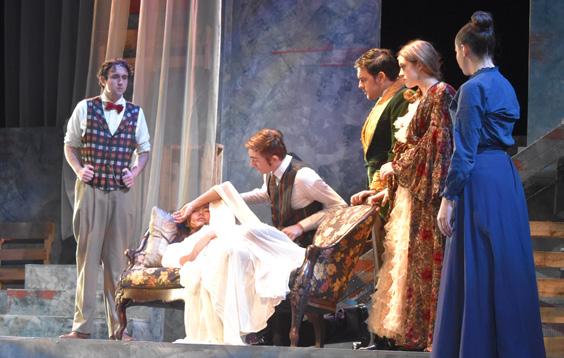
Art history professor Kenneth Craig, who taught at Boston College for 45 years before he died in August, was “one of the best and most influential” professors in the department, according to Aurelia Campbell.
“He was an extremely generous, welcoming, kind, thoughtful colleague and professor,” said Campbell, the art history director of undergraduate studies. “He was incredibly warm and nurturing, always giving so much attention to everyone. He went out of his way to make you feel special.”
Craig began his career at BC in 1977,
serving as the chair of the fine arts department from 1985 to 1988 and later as the director of undergraduate studies of art history. During his time at BC, he taught courses such as Northern Renaissance Art, the Age of Rembrandt, Greek Art and Archaeology, and more.
According to Stephanie Leone, BC’s art history department chairperson, Craig gave his heart and soul to his work.
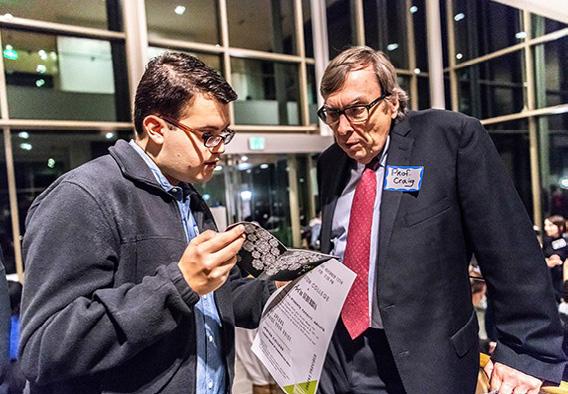
“He was especially dedicated to his teaching and to his students,” she said. “His door was always open. There were always students around his office. … He struck such a nice balance between setting high academic expectations for the students but also showing compassion and understanding and engaging with them as people.”
Chestnut Hill, Mass.
Studying abroad is exciting yet stressful, but these tips can help you prepare.

A proposed $15 million tax increase is intended to improve public school facilities and local infrastructure, according to Newton Mayor Ruthanne Fuller. But Greg Reibman, the president of the Charles River Regional Chamber, said it may put a strain on the local economy.
“There’s much we need to understand about these proposals in the months to come and we will be listening carefully,” Reibman wrote in an Oct. 18 statement to The Heights. “But at a time when our employers are battling inflation, wage pressure and a looming recession, a property tax increase feels like a lot to ask of our business community.”
Reibman said the chamber has not decided its final stance on the proposed tax hike.
The proposal, announced Oct. 17, would fund student resources and facilities improvements for Newton Public Schools, park maintenance, senior services, and sustainability projects, according to a City of Newton web page.
“These are things that make Newton a City where people want to live and raise families, where businesses want to locate, and where shops and restaurants want to open their doors,” Mayor Ruthanne Fuller wrote in a statement to The Heights on Oct. 21.
Business owners have called for more funding, according to Fuller.
“ I’ve heard from countless Newtonians, including our small business owners, who want more funds for critical programs and services for the Newton Public Schools, for senior services, for more investments in our parks, playgrounds, courts, athletic fields, and trees,” Fuller wrote in the statement.
The increase would require a majority vote at a special election to override
Massachusetts’ Proposition 2 ½, which places a 2.5 percent cap on annual increases in levy limits.
Reibman said the mayor gave the chamber—composed of businesses in Wellesley, Watertown, Needham, and Newton—a heads up about the proposal, though he didn’t specify how far in advance. While he understands that Newton is facing budget difficulties, the proposal comes at a tough time for local businesses amid a period of nationwide inflation, Reibman said.
“All the economic indicators make businesses really nervous,” Reibman said in an interview with The Heights. “A lot of businesses are having a hard time getting by right now, and to increase their property taxes at this time, it’s going to be really challenging, which will make this a really difficult decision for a lot of businesses in terms of whether they would support this or not.”
See Tax Increase, A4
 By Jack Bergamini Asst. Sports Editor
By Jack Bergamini Asst. Sports Editor
Four of the last 10 times Boston College field hockey has faced Boston University, the game has gone to overtime.
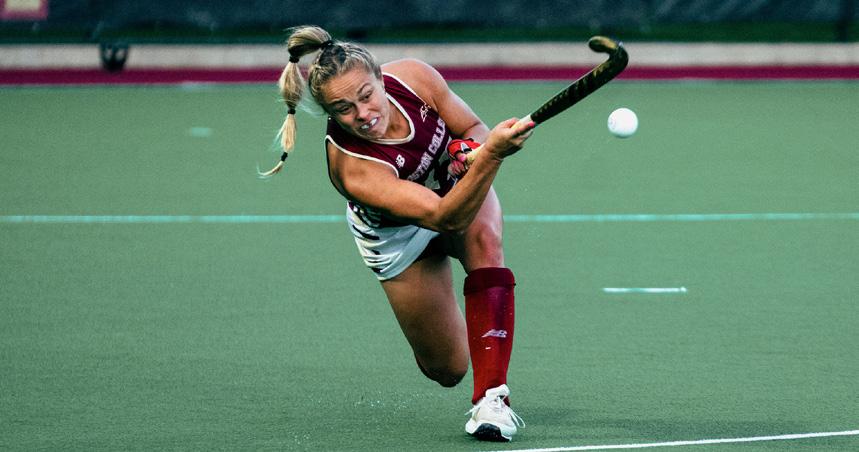
For 41 minutes, it looked like Sunday’s game would make that statistic five out of the last 11.
But a Kara Heck goal broke the 1–1 tie in the 41st minute and cata -
pulted the Eagles (7–9, 2–3 Atlantic Coast) to a 3–1 victory over BU (8–8, 4–1 Patriot League) in the 44th Battle of Comm. Ave. Sunday afternoon.
“We had to have that win,” BC head coach Kelly Doton said. “Just getting some momentum back and some confidence—it’s amazing what winning can do.”
It was a defense-heavy game on both sides. The Eagles’ offense, however, displayed far more fire -
power than BU’s, outshooting the Terriers 31–5.
BC struck first with a Lois Lekawael goal off a penalty corner for her first goal of the season. But 38 minutes passed until the Eagles’ next goal, forcing BC to rely on goaltender Emily Gillespie and a high-octane defense to keep the Eagles in the game.

Craig was always attentive and thoughtful in conversations with students and colleagues, Campbell said.
“He would remember what you said in conversations with him and bring it up later just to follow up,” she said. “He wanted you to know he was listening. … People felt they could open up to him because he wasn’t nosey or offering unsolicited advice. He was just there to listen.”
Leone shared how Craig brought a student-centered teaching approach to important conversations and meetings within the art history department.
“He was the conscience of our department,” she said. “He was the one in departmental discussions and decision-making that always kept us focused and reminded us what mattered, which is our teaching.”
Megan Streeter, MCAS ’24, said she took at least one class with Craig every semester of her first two years at BC.
“He makes me excited about post-grad because I know that maybe one day I can have a job I love as much as he loved his job,” Streeter said. “He was also the most knowledgeable professor I’ve ever taken a class with.”
Josephine Kim, a student and advisee of Craig’s, said he was her rock when she was conflicted about pursuing art history or going to medical school.
“I would sit down with him and talk for like an hour almost every month because I was just really, really conflicted about what to do and he would give me amazing advice and reassure me that whatever I do, it should be something I’m happy
about doing,” Kim, MCAS ’23, said.
When she speaks to students declaring the art history major or minor, Campbell said most of them
us to one day be smarter than him. He was always rooting for our success.”
Even in serious situations, Kim said Craig always made students smile, providing necessary support and an uplifting attitude.
As a professor and art historian, Leone said she most admired Craig’s devotion and patience.
for his interpretation of Pieter Aertsen’s still-life paintings.
bring up the impact Craig had on their decision.
“It seems like nine times out of 10 when I ask students what inspired them to declare that major or minor it was because of professor Craig,” she said. “They either took one of his classes, maybe for an art credit or just from other interests, and then the student totally fell in love with the discipline because of him.”
Kim said one moment with Craig that stood out to her were the final words she exchanged with Craig over email.
“It was when I decided to finally drop pre-med and just focus on art history this last summer,” she said. “He emailed me saying, ‘Just do what you want to do and do what you will make you happy,’ and I feel like those words over email [show] just how much he cared for me throughout the few years I’ve got to know him.”
Streeter said while Craig was a difficult professor, he was always encouraging his students to further explore the discipline.
“A lot of times when a professor is super intelligent or a tough grader they can feel intimidating or out of reach,” she said. “Although professor Craig was demanding, he was never discouraging. He wanted
“He would always teach with laughter and make the entire class and just feel excited to learn about what he was teaching, and just his endless support and guidance for the students,” Kim said. “I strive to be, hopefully, a professor like him one day.”
Streeter also said that although Craig took his discipline very seriously, he still brought humor into the classroom.
When studying Hieronymus Bosch’s “The Garden of Earthly Delights,” she said Craig fixated on a man in the painting lying with a music sheet covering his naked body.
“He was hilarious,” she said. “He made art history fun.”
“[He had an] incredible devotion to his profession,” she said. “The other thing that I admired about him as an art historian was his patience when looking at and studying art. He would look at a painting over and over to see new things and he had an amazing
“He was able to show that there was a symbolic connection between the biblical scene in the painting and the representation of the stilllife objects,” she said. “This has a lasting impact that goes beyond BC and anybody reading about Aertsen and about Netherlandish painting will notice the work of Dr. Craig.”
According to Campbell, in past years she and Sheila Gallagher, a studio art professor, talked about having a designated “Ken Craig Appreciation Day” to showcase to Craig how special he was to the BC community.
ability to evoke the pictorial image through words.”
Leone also said Craig is recognized globally by art historians
“Although we never got the opportunity to do so, we wanted to take him out and just let him know how much we appreciated him because he was just so special and beloved to so many people,” Campbell said. “He was here for 45 years. Art history at Boston College was synonymous with Kenneth Craig.” n
Innovative solutions are not necessary to combat gun violence, according to U.S. Senator Chris Murphy.
“Here’s my plea to you: Don’t search too hard for innovative solutions,” Murphy said. “We really don’t need to make up new solutions. We actually know what works.”
Boston College Law School’s Rappaport Center for Law and Public Policy welcomed Murphy on Friday as the keynote speaker of its virtual conference on gun laws and safety.
Murphy, the junior senator from Connecticut, explained “what works” with respect to gun safety—taking greater caution in distributing weapons, specifically assault weapons.
“We don’t allow for you to buy assault weapons in [Connecticut],” he said. “That doesn’t mean that you can’t get them. It doesn’t mean that bad people still can’t get weapons.
We just make it a lot harder for that to happen.”
Murphy said these methods result in lower rates of gun violence, directly comparing Connecticut’s rates to Florida’s.
ownership may be a contentious issue today, U.S. history reflects a notable precedent for gun control.
“From the very beginning, America was a country that regulated guns,” he said. “Our Founding Fathers believed in the regulation of guns. Fast forward to the 1800s, and states all across this country, especially as the handgun became more ubiquitous, started passing laws that, today, would be considered politically unpalatable.”
Murphy said the fight against gun violence does not require innovative solutions
background checks for prospective gun owners, and increased the budget for anti-gun violence programs at the state and local levels, Murphy said.
“I’m proud of what we did,” Murphy said. “I think what we passed this summer is a breakthrough. I think it fundamentally shifts the power dynamics on the issue of gun violence.”
basically providing an invitation to conservative, politically motivated district court and appellate court judges to just make up whatever justification they need in order to impose their political views on the country,” he said.
A panel of guest speakers further unpacked the impacts of Bruen following Murphy’s keynote address.
Other panels at the conference focused on community violence prevention as well as new gun laws and regulations currently being implemented in the United States.
“Connecticut has a rate of gun violence 400 percent lower than Florida,” he said. “People in Connecticut are different than people in Florida. I’m sure that’s true, but they’re not 400 percent different. The reason that we have lower gun violence rates is because we’re just a lot more careful about who gets a weapon.”
Murphy also noted that while the regulations of guns and gun
But, recent gun legislation passed in the Senate this summer required “new” solutions to gain bipartisan support.
“It wasn’t innovation dictated by policy needs, it was innovation dictated by political needs,” he said. “Again, I believe that there’s not a lot of reason to innovate if you’re just looking for what works, but we have to innovate in order to find 60 votes.”
This new legislation implemented red flag laws, enhanced
Murphy also discussed the implications of the Supreme Court’s recent decision in New York State Rifle and Pistol Association v. Bruen.
In the landmark case, the court ruled that the Second Amendment protects the right to publicly carry a firearm.
“The Bruen decision is just
Murphy called his audience to action in his address, urging people to see the full adverse effects of guns on American life.
“American violence is mostly about guns,” he said. “It’s mostly about the guns and our decision, a long time ago, to allow these weapons to move into America at a rate without parallel amongst like countries. And so I just want
frame
discussion with
to
your
a sense of urgency about getting this right.” nGRAPHIC BY PAIGE STEIN / HEIGHTS EDITOR Craig, from A1
“People in Connecticut are different than people in Florida. I’m sure that’s true, but they’re not 400 percent different.”
“I’m proud of what we did. I think what we passed this summer is a breakthrough.”
“He was also the most knowledgeable professor I’ve ever taken a class with.”
“Although professor Craig was demanding, he was never discouraging. He wanted us to one day be smarter than him.”
Boston College students can now get medication delivered to their doors with Capsule—a pharmacy that provides delivery service.
“It kind of worked almost like Uber Eats,” Olivia Dawley, MCAS ’25, said. “I just gave my address and my information and then set up a delivery time.”
University Health Services (UHS) added Capsule as a pharmacy option for students this spring, according to Director of UHS Doug Comeau. Capsule can deliver any over-the-counter or prescription medication, including medications prescribed by UHS, directly to a student’s place of residence.

“While we have multiple pharmacies on the periphery of the
campus, Capsule’s delivery option allows a student, if desired, to not leave campus to fill a prescription,” Comeau said.
According to Comeau, students who choose Capsule as their pharmacy option will receive a text message when their prescription is ready. After verifying insurance information, students will select a two-hour window and location for delivery, Comeau said, similar to Uber Eats.
Comeau said someone has to pick up the prescription directly from Capsule when it arrives, so there is no option to leave medication unattended at an address.
Student feedback for Capsule has been great, according to Comeau.
Using Capsule was “super easy,” according to Dawley. At the end of the spring semester, Dawley went
to UHS for a bad cough and was prescribed medicine, which she said Capsule delivered to her.
“I would get text updates … when I would be getting it just to make sure that I was there to pick it up,” she said.
Caroline Sloan, MCAS ’24, said she decided to use Capsule when UHS prescribed her antibiotics earlier this week. Sloan said she was initially wary of using Capsule because she was unfamiliar with the service, but it proved to be convenient and its customer service was very helpful.
“It went really smoothly,” Sloane said. “I think the company itself is really well made.”
Both Sloan and Dawley said they previously had no idea Capsule was an option available to them or other students.
“I feel like you would probably only know about it if you’ve done it before,” Dawley said.
Though she has only used Capsule once, Dawley said she would definitely use it again.
“It’s a lot more convenient than trying to figure out how to get to a CVS or a pharmacy nearby,” she
said.
Sloan also said she would use Capsule again to get prescriptions from UHS.
“I think that it was a really easy and great way to get my medication,” she said. “I live off campus so it’s nice to have it delivered. I would totally use that again.” n
A person’s faith can sustain them through times of trouble, from uncertainties in the future to humanitarian crises, according to former U.S. Ambassador to the Holy See Ken Hackett.
“Faith is easy. Religion is tough,” Hackett, BC ’68, said. “So during all of these [crises], there was an element of religious tension. That was really difficult to deal with in Bosnia, in Ethiopia … so I would say it was my faith that sustained me.”
Boston College’s Church in the 21st Century (C21) Center welcomed Hackett—who is the former president and CEO of Catholic Relief Services (CRS)—on Thursday night to reflect on his faith, time in the U.S. Foreign Service, and
his new book The Vatican Code: American Diplomacy in the Time of Francis.
When asked why he decided to join the Peace Corps after graduation, Hackett detailed an exchange with a longtime friend and fellow BC alumnus.
“Carmen and I were part of the same fraternity, and we both played lacrosse together,” Hackett said. “We’re good friends, and we’re walking one day in probably April of ’68 from Fulton to McElroy to have lunch and there’s a table set up in the foyer of McElroy saying ‘Sign up for the Peace Corps.’ That was the moment that he said, ‘You want to sign up?’ and I said, ‘Yeah.’”
The Peace Corps sent Hackett to Ghana, where he said he worked for three and a half years.
“It was an exposure to people who were wonderful, but different,” Hackett said. “That opened my eyes in a way to just how different
and how much the same they are.”
Hackett described his time in Ghana as a “transformative experience” that allowed him to immerse himself in different cultures and better understand and appreciate the lives of people living outside the United States.
After he came back from Ghana, Hackett said he worked at the Boston Whaler boat company sanding boats before he started at CRS, where he stayed for nearly 40 years.
During his time at CRS, Hackett witnessed global tragedies, including the Ethiopian famine from 1983 to 1985 and the Rwandan genocide. Hackett explained that it was his faith that kept him going through those tragedies.
“I would say it was my faith that sustained me,” he said. “I remember discussions with my staff about ‘Where’s God?’ Look, we just came back from seeing 5,000
bodies. Where’s God?”
Hackett also discussed the lessons he learned while working in Vatican City. One of these lessons, he said, is the best way to make progress at work is by getting to know your coworkers through conversation.
“Remember, it’s not transactional,” Hackett said. “It’s all relational. You have nothing to sell to them, and they are not going to buy.”
For Peter Watkins, MCAS ’25, Hackett’s message about faith as part of his work in the Vatican was particularly interesting.
“I think especially the matters of his faith [that] he brought up are important to me,” Watkins said. “And especially the way that faith is … incarnated in the work of the Vatican embassy. There are many good things he said about the way diplomacy works internationally that I was quite impressed by.”
Karen Kiefer, director of the C21 Center, reflected on the value of having individuals like Hackett speak on campus about their Catholicism.
“Back when the sexual abuse crisis broke in 2002 in Boston, Father Leahy came forward and said, ‘I want to take all the major riches of this Jesuit Catholic university and put them at the feet of the church and start to renew,’” Kiefer said. “And we do that through conversation … we think, we listen, and we act.”
Hackett concluded his talk with a question-and-answer session, urging students to not worry about the future.
“I have kind of a Nike philosophy: Say a prayer and jump,” Hackett said. “I mean, you don’t control [the future] and to think you do is presumptuous. … I say if you’re in your 20s, enjoy it. Do crazy things.” n
an open question. That is, I think, the most important question.”
Sengupta moderated a panel of Boston College professors at a lecture on Wednesday titled “BC@UNCOP Series: On the Road to Sharm El-Sheikh.”
The Russian war in Ukraine is pivotal to the future of combating climate change, according to The New York Times’ International Climate Correspondent Somini Sengupta.
“Will this conflict slow down climate action or will it accelerate climate action?” Sengupta said. “That is
The Schiller Institute for Integrated Science and Society hosted the event as part of the lead up to BC sending a delegation of students and faculty to the United Nations Climate Change Conference in November.
During her lecture, Sengupta cited
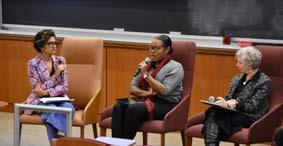
gradual increases in global temperatures as reason for concern about the state of the environment.
“The average global temperature right now is about 1.1 degrees Celsius higher today than it was 150 years ago at the beginning of the industrial era,” she said.
According to Sengupta, keeping the global temperature from rising another 1.5 degrees Celsius is essential to preventing additional, irreversible damages. This would require cutting total global greenhouse gas emissions by around 45 percent before the year 2030, she said.
“There’s a pretty good chance that the world can keep the average temperature rise within 1.5 degrees, and if that can be done then we have a pretty good chance of averting some of the worst impacts,” she said.
Sengupta then turned to a panel of BC faculty experts on climate change and the environment. Members of the panel included Lacee Satcher, Hanqin Tian, Sandra Waddock, and David
Wirth.
Tian, the Schiller Institute’s professor of global sustainability, said staying within the 1.5 degree threshold is possible but will prove challenging.
“It needs immediate action,” Tian said. “It’s challenging, but it’s possible.”
Satcher, a professor of sociology and environmental studies, said reflecting on past environmental policies is critical to shaping future decisions.
“In terms of policy, one of the ways that the social sciences are contributing now and will continue to contribute is thinking about the effectiveness of past policies, in terms of outcomes on human beings at the global level, but also at a more local level—at the state level and the nation-state level,” she said.
Wirth, a BC Law professor, explained economic policies that could encourage the use of green energy.
“We have a series of subsidies and incentives that are designed to shift the economy in the direction of green energy—in the direction of installation of electric vehicle charging stations and
a whole variety of small interventions that collectively will transform society,” he said.
Waddock, the Galligan Chair of Strategy in the Carroll School of Management, said that broad economic changes are key to mitigating the climate crisis.
“Most companies are not going to make the shifts that are necessary to achieve the temperate climate targets until and unless the system around them changes,” she said. “The system around them isn’t going to change until we change the way we understand economics.”
Sengupta said while the United States has made progress in addressing the climate crisis—most significantly through the Inflation Reduction Act—it is not enough to offset its fossil fuel production.
“There’s been movement,” she said.
Newton Mayor Ruthanne Fuller proposed a $15 million tax increase at a city hall address on Monday, citing the city’s need for additional funds for improvement projects.
The increase would require a majority vote at a special election to override Massachusetts’ Proposition 2 ½, which places a 2.5 percent cap on annual increases in levy limits.
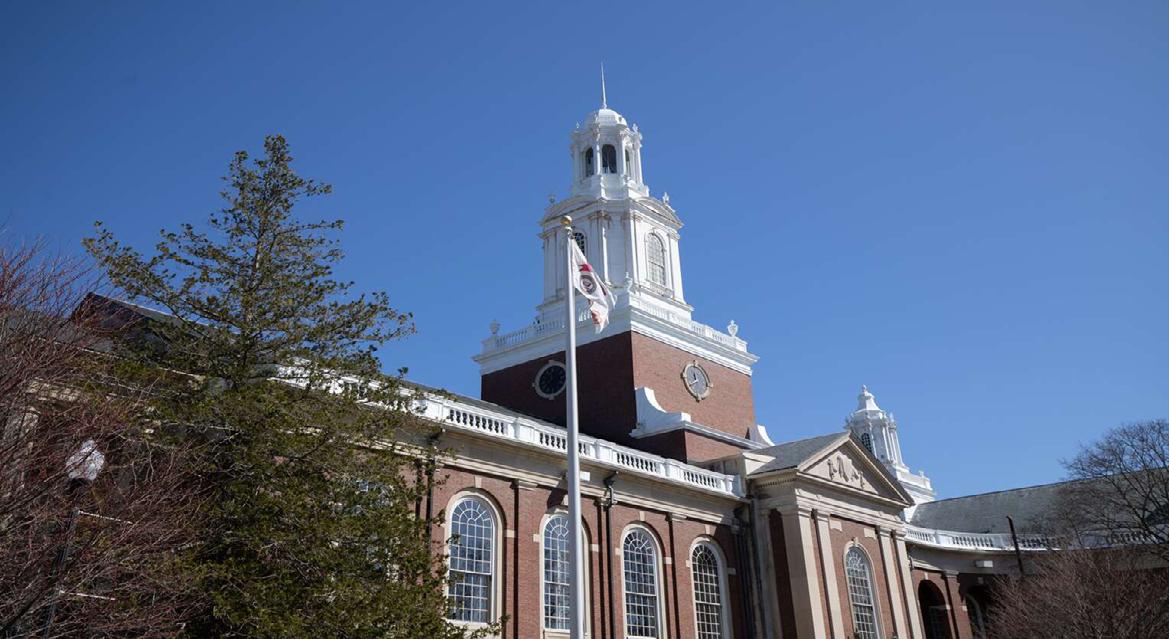
Newton residents can vote for three ballot items concerning the pro-
posed override at a special election, set tentatively for March 14, 2023.
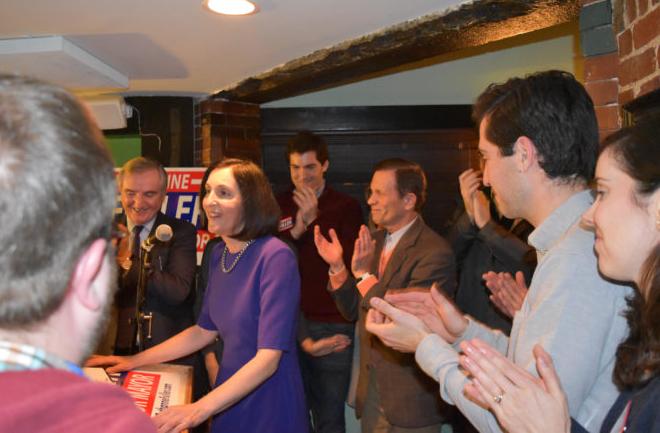
The city has created a webpage about the override, with a calculator available for residents to assess how the proposed tax raise will impact them should it pass.
A property valued at $1.2 million—Newton’s median—would see a tax raise of $290 in the next fiscal year, according to Fuller. The number would grow by another $183 around 2030.
Newtonians have voted to pass two overrides since the enactment
of Proposition 2 ½—once in 2002 and again in 2013, according to Fuller.
The funds raised through the proposed tax increase, should the override pass, will be used toward an array of initiatives, according to the website.
Such improvements include the renovation of several public schools in Newton, improvements to parks and recreational facilities, and increased efforts to promote sustainability, among others.
Fuller said that since the COVID-19 pandemic, the city has
from A1
After the COVID-19 pandemic put a strain on local businesses, Newton directed about $5.2 million in American Rescue Plan Act (ARPA) funds toward economic recovery and improvement of village centers, according to the city’s
shops hit especially hard,” Fuller wrote in the statement. “We recognized that and acted.”
Newton residents can vote for three ballot items concerning the proposed override at a special election, set tentatively for March 14, 2023.
Reibman said Newton businesses may be working within a recession
that the chamber has not come to a firm decision as to whether it supports the increases or not.
“We’re going to listen to the mayor,” Reibman said. “We’re going to want to really understand the finances and the proposal better. And, fortunately, we have several months to make that decision and to understand things so we look forward to that process of working with the city and listening to businesses.”
Fuller called on both businesses and residents to support the increase. The city levies $10.52 per $1,000 of assessed property value for residential properties, compared to $19.95 per $1,000 for commercial ones, according to the City of Newton’s website.
“Now is the time to come together, our residents who pay 86% of the City’s total taxes and our businesses who contribute 14%, to invest in this wonderful community,” Fuller wrote in the statement.
The chamber has a great relationship with Fuller, according to Reibman.
paused almost all of its capital investments, diverting funds instead toward alleviating the pandemic’s impacts.
“Over the past two and a half years, this financial planning has sometimes felt like an ever-changing 3D chess board with the dramatic human and financial impact of the pandemic,” Fuller said in Monday’s address.
While one-time federal funding from the American Rescue Plan Act allowed Newton to address some of its most pressing issues, Fuller said the city needs additional funds to
push forward new initiatives.
“The Financial Forecast makes clear the challenge we face,” she said. “Funds from the general operating budget, our debt capacity, the onetime Federal pandemic funding, and other revenue sources cannot absorb all our essential capital and ongoing operating investments in a timely manner and keep us a AAA-rated city.”
City officials will communicate with residents regarding the proposed tax increase in the upcoming months, Fuller said. n
website.
Fuller said in the statement that the city cut alcohol licensing fees for restaurants, created an incentive program to help businesses hire employees, and jumpstarted outdoor dining with the Newton Al Fresco program, among other initiatives supporting local businesses.
“The pandemic was no doubt a difficult time economically for so many, with restaurants and small
by the time voters head to the polls in March.
“[An increase in taxes] will have to be paid for by customers and the businesses,” Reibman said. “In most cases, there’s no way for businesses to keep absorbing inflation, with high wages, the cost of so many things have gone up. Insurance, every product you buy, and so it’s got to come from somewhere.”
Reibman said he wanted to stress
He said the organization is confident that she will continue to share information with the chamber as the vote nears, but he doesn’t know if now is the right time for the proposed increase.
“I know that she’s trying to do what’s best for the city,” Reibman said. “I just don’t know whether businesses can afford the tax increase.” n
Newton Mayor Ruthanne Fuller detailed how the newly announced proposal for a $15 million tax increase would benefit Newton Public Schools (NPS) at a virtual town hall meeting Thursday night.
Funds resulting from the increase—which would require a majority vote among Newton residents to override Proposition 2 ½, a Massachusetts law that places a 2.5 percent cap on annual increases in levy limits—will primarily go toward funding several city projects, with particular emphasis on improving the Newton Public Schools (NPS), according to Fuller.

“I’d say Newtonians have every right to have high expectations for our city,” Fuller said. “And I know how much work we have in front of us to be the community of choice, especially for parents and families coming here to take advantage of our wonderful school district.”
The proposal, as detailed by Fuller, will include two debt-exclusion overrides totaling $5.8 million that will go toward the renovations of Countryside Elementary School and Franklin Elementary School, entailing a temporary tax increase in about seven years that will last 30 years.
The proposal also includes an operating override—a permanent tax increase that, if passed, will start on July 1, 2023.
“[Countryside is] way overdue to be completely renovated, and over at Franklin we have a 100-year-old building … [where] lots of the student spaces are in the basement,” Fuller said. “Though if our voters vote ‘yes,’
we’ll have two great new buildings here—modern, accessible, all the right spaces with all the right sizes.”
A significant portion of the operating override, which will total roughly $9.2 million, will go toward NPS, with the rest allocated to repairing streets and sidewalks; maintaining parks, fields, courts, and playgrounds; planting and nurturing more trees; improving senior services; and addressing sustainability and climate change.
“Please know that 75 percent of the funds in this override are for our children, which are literally our future,” said Fuller. “It’s the core value here in Newton—we believe in supporting children. We believe in education, and that’s what this override at its heart is all about.”
Should the proposal pass, $4.5 million will be dedicated to supporting general student needs, according to Fuller, while $775,000 will go specifically toward renovating NPS’ Horace Mann Elementary School.
“It’s just too small,” Fuller said. “We need an addition, as we even had to lease some [modular buildings] in the last few years to get the space that we needed. Once we have this addition in place … we get the right-size classrooms, you have the right-size cafetorium, the right-size library, and all the good things with the special education and student services spaces.”
Current Interim Superintendent Kathleen Smith said that the primary goal of using the funds is to maintain NPS’s status as a high-achieving district.
“We are right where we need to be,” Smith said. “The one thing that I think is important for the community to understand is this is where we do not want to lose ground.” n
The Newton Free Library hosted a webinar on Tuesday night regarding water protection rights and spirituality in honor of Indigenous Peoples’ Day, which occurred on Oct. 10.
“As the guardians of this land, we live amongst the winged fish, the animals, the insects—we live within them. We don’t control them,” said Hiawatha Brown, a Narragansett elder and one of the panelists. “And in the mainstream view of things, people are perceived to be the kings and queens, for lack of better terms.”
During the event, the panelists—Kasike Jorge Estevez, Liz Santana-Kisere, Robert Quesada, and Brown, all members of local Indigenous communities—spoke about their cultural connections to water and the environment.
The panelists emphasized how wa-
ter pollution and issues pertaining to Indigenous land acknowledgment have negatively impacted their groups, both spiritually and economically.
After a brief introduction from Ellen Meyers, director of programs and communications at the library, Quesada opened the event with a traditional Danza and prayer ritual. He wore traditional Coyokiztil attire, which includes a handmade headpiece from coyote pelts in addition to face paint and decorative jewelry. The Indigenous prayer combined drum rhythms with intricate dance moves and specific phrases and movements directed at the altars placed around the room.
Estevez, chief of the Taino people and former program coordinator at the Smithsonian National Museum of the American Indian, spoke about the customs and traditions of the Taino, highlighting their location and connection to water. Estevez began his part of the panel by describing his upbringing in San Juan de la Maguana in the Dominican Republic.
Maguana is located in the middle of the island, isolated and secluded, which is part of why many Taino traditions have survived in the region—it’s difficult for outsiders to access.
In the Taino culture, if one does not have children, it is their responsibility to pass down the knowledge from their parents to three new people, according to Estevez.
These three people will pass it on to another three and another three, preserving culture across generations.
Estevez ended his presentation with a troubling image of various beaches in the Dominican Republic, showcasing the pollution and litter that has changed the landscape from beautiful and bright to dark and dreary.
“This is what Western progress has done to our waters, and those are just the beaches in the Caribbean today,” Estevez said. Similarly, Santana-Kisere, the current tribal historical preservation officer for the Nipmuc Indians, pointed out the progression of pollution and destruction of local ecosystems.
Santana-Kisere explained a recent study her grandson conducted at Haskell Indian Nations University in which he concluded that regional bodies of water have reached hazardous levels of harmful bacteria and algae bloom.
Instead of the freshwater fish that once thrived in the New England waters, zebra mussels, asian clams, and algae populations have taken over, reproducing at a rapid rate.
Santana-Kisere encouraged the general public to take action sooner than later.
“When you talk about water, that’s how we survive, and only we—as the people and as stewards of this land— can change the damage that’s being done today,” Santana-Kisere said.
Brown was the final speaker of the night. He explained the nuances of indigenous claims to land versus how those claims translate into ownership under federal law.
He explained that while federal reservation land is under the guardianship of individual tribes, the land
itself is owned by the U.S. Department of the Interior, making the indigenous preservation of their land contingent on federal approval.
This tension is one of many examples of the ways different peoples interact with the land they live on, according to Brown.
“There’s a major difference between the European understanding of property and how they attain it or retain it as opposed to how indigenous people live on this Earth,” Brown said.


The panelists closed out the session by encouraging the audience to educate themselves and get involved in issues pertaining to local indigenous communities.
“Come to our events, come to our ceremonies,” Quesada said. “As Bruce Lee said, come with your cup empty and fill it with our stories—with our heroes, with our knowledge, with our traumas. Fill it with the knowledge of what we have gone through for 500 years. And not only that, but the years before that when we were flourishing.” n
The playful sound of the paws on the ground and the barks of mingling dogs dressed as dinosaurs, princesses, and superheroes competing for the best Halloween costume echoed throughout Newton Centre on Thursday afternoon.

A poster inviting passersby to “experience new flavors” sits outside Glazed Bytes, a cafe that opened Oct. 1 on the second floor of The Shops at Chestnut Hill. It’s an appropriate greeting, as the cafe offers dynamic new flavors and fresh takes on coffee shop classics.
The shop’s menu entices customers at first glance. It boasts a selection of “croffles”—a crossover between croissants and waffles popularized in South Korea—and unique specialty teas such as Yuza Citron Fruit Tea and Blue Flower Earl Grey.
Glazed Bytes also brews drink staples, including cappuccinos and assorted lattes. Its signature drink is the Cloud Foam Latte, which has a “richer and creamier” flavor profile than regular cold foam according to James Park, the cafe’s founder.

Park came to the Boston area from South Korea to attend Northeastern University. He majored in finance, which he said has contributed greatly to his ability to open and operate the
cafe. A return to South Korea helped him develop Glazed Bytes into what it is today.
“During [the COVID-19 pandemic], we had the opportunity to stay in Jeju, South Korea for two years,” Park and his wife, Elizabeth So, wrote in an email to The Heights. “We are both foodies and love trying out new cafes and restaurants. The moment we had our first bite [of croffles], we fell in love with this unique dessert, [and Park] decided he wanted to bring this dessert to the Boston area.”
At Glazed Bytes, customers have the option of trying “croffles” on their own, or with sweet or savory add-ons.
The Apple Jam Crisp Croffle, one of the “Sweet Bytes,” is a harmonious layering of flavor and texture: The sugar sprinkled on the croffle provides crunch in contrast to the dough, and the scoop of rich vanilla ice cream melts through the fruity sugars of the apple jam. The apple flavor makes it a hit among those looking for a new fall treat.
Savory croffles come with cheese melted on top and a sprinkling of ev-
erything bagel seasoning, pepperoni, or barbeque bacon. The everything bagel seasoning adds a dash of saltiness and toastiness to offset the inherent sweetness of the croffle.
In addition to developing distinctive desserts, Park refines his passion for coffee through experimenting with new recipes. While in Jeju, Park tried many lighter roasts of coffee, which eventually led to them using “thirdwave coffee” at Glazed Bytes.
Park said “third-wave coffee” is characterized by the use of higher-quality beans, light roasting techniques, and a focus on sustainability. Glazed Bytes sources its coffee from local roaster Fazenda.
The subtlety of the light roast coffee is noticeable, resulting in a less bold and bitter drink with more sweetness. The seasonal pumpkin spice latte is a delightfully smooth blend of coffee, creaminess, and pumpkin, spiced with notes of cinnamon.
Read the rest of this story at www.bcheights.com
The chorus of dogs traced back to a packed Baramor restaurant, which was hosting Jr’s Barktoberfest, a philanthropic event benefiting canine charities. Baramor encouraged guests to dress their pets for a costume competition, participate in a raffle, and enjoy its menu items.
Though most of the humans in attendance weren’t in costume, the pups brightened the cool and gray afternoon. They wagged their tails and pounced in excitement. One even gave a person a friendly nibble.
The humans matched the dogs’ energy, though, talking among themselves, sampling wine and beer, and ordering American classics off of Baramor’s menu.
“I’ve been here the last few years,” attendee David Proia said. “We love to decorate and add costumes for the dog. It’s a great event to hang out at,
and the cause is so great.”
Lauren Barbo, the founder of the nonprofit Jr’s Paws For a Cause, explained the organization behind the event.
“We are a spay-neuter educational outreach program volunteering in the Dominican Republic,” Barbo said. “We go down with all our medical supplies [and] do spay-neuters and other medical procedures to teach animal welfare.”
Barbo said she always recruits a local rescue to have adoptable dogs at the events that the nonprofit hosts. Shultz’s Guest House, an animal rescue shelter, brought dogs to Thursday’s event.
A black Lab named Shadow greeted attendees with her cuddly and cheerful personality. Michelle Ratner, a volunteer at Shultz’s Guest House, held onto Shadow, who wagged her tail among furry friends dressed up as dinosaurs and superheroes.
The shelter introduced each dog to attendees, stirring up waves of applause.
Read the rest of this story at www.bcheights.com
Four years ago, Matt Fonte was going through his nightly routine of putting his two daughters to bed while they talked of the various gadgets they planned to invent, prompting his younger daughter to ask if they could make an ice cream
was a fogless mirror for shaving, according to Fonte’s childhood friend Erik Skulte.
“[He put] copper strips on the back of mirrors and [attached] it to a battery to make an electric current to keep the mirror fogless,” Skulte, who also serves as ColdSnap’s senior program manager, said. “He actually contacted a friend’s father who is a
ed with people that were caring and helped support me, and I thought it was a good foundation for starting my career.”
Fonte continued to build his technical engineering skills while working at his father’s manufacturing plant throughout college. At the plant, he said he learned about forming metals and different mechanical properties of material metals, which motivated him to further his education at Tufts University, where he received a masters and Ph.D. in mechanical engineering.
For 11 years, he worked at his father’s plant during the daytime and spent nights and weekends taking classes.
machine for their very own home.

Fonte, BC ’94, however, explained to his daughter that ice cream machines are not common household items.
“My daughters seemed disappointed … so we wrote the idea in their invention journal,” Fonte said. “We signed it and then the next day I went into work, and I started asking my engineer friends, ‘Do you think we could freeze six ounces of ice cream in a minute?’”
This question became the basis of ColdSnap—Fonte’s latest startup, in which he engineered a machine that provides single servings of ice cream, frozen coffee, and frozen cocktails in about a minute.
Growing up, Fonte had a knack for entrepreneurship, constantly brainstorming ideas for new inventions. One of his earlier concepts
patent attorney [to see if] there’s a patent on the fogless mirror”
Skulte said this idea, along with Fonte’s determination to execute it, was a clear sign of what was to come from Fonte.
“Even at a young age, he showed a very strong entrepreneurial spirit,” Skulte said. “I think that was an early indication that he had the mindset of ‘behind every problem is a solution.’”
When deciding what to pursue in college, Fonte said he was interested in both business and engineering, but he decided to study finance at Boston College’s Carroll School of Management.
“I think my studies really gave me a sense of how much I enjoyed my organizational classes and how to handle money and account for money,” Fonte said. “And I was surround-
After receiving his graduate degree, his father sold the manufacturing plant and gave Fonte the money to start Mx Orthopedics—a manufacturing business that specialized in orthopedic implants. But instead of using common metals found in orthopedic implants, Fonte said he used a nickel titanium alloy called nitinol. Because it is a malleable “shape memory metal,” nitinol returns to its original shape when heated up
“The idea was that a surgeon could stretch an implant over a fracture so [that when] the staple or the screw or the plate or the wire is released from the delivery device, it can pull the bone fragments together, and that would keep constant compression at the bone site and the patient would heal faster,” Fonte said.
After running Mx Orthopedics for almost five years, Fonte decided to sell the business and start working on Coldsnap.

Inspired by his daughters’ idea, Fonte invested in kick starting
ColdSnap. He started with one question: Do you think we could freeze six ounces of ice cream in a minute?
“And everybody said, ‘I don’t think so. If you could, somebody would have already done it by now,’” Fonte said. “But I wasn’t sure about that because there are Cuisinart ma-
“[Fonte’s] the perfect storm of being very hard working, very entrepreneurial, willing to try things out, and willing to fail,” Skulte said.
To put his idea to the test, Fonte had a friend help him create a computational model to examine the plausibility of the concept.
By Stephen Bradley Magazine EditorWhile many Boston College students are posting pictures of themselves sipping wine along the Seine or hiking the Swiss Alps, those of us studying abroad next semester are waiting for our turn to travel the world.
After the stress of finals and the holiday season, you will want to relax before packing your bags, boarding your flights, and moving to a new country. Here are some of my tips on how you can begin preparing for your semester abroad now to ensure a smooth transition.
When you arrive to your host city, there will be a lot on your plate. I recommend you start thinking about some weekend adventures, even if it is just a rough idea. Jotting down locations, dates, and methods of travel now will help alleviate some of the stress at the beginning of the semester.
Make sure to talk with your friends who will also be abroad—ask when you can visit them in their host cities, and put those locations down in your
calendar. You can also coordinate with friends and figure out when and where you would want to take trips together.
My advice is to print out physical calendars for the months you’ll be abroad, and pencil in some plans. Or, you can use Google Calendar and input some tentative ideas.
For now, I would hold off on actually buying the travel tickets because plans may change, but at least having an idea of where you might want to go is a great starting point.
Since you will spend an entire semester in a different country, you’re going to have to pack a lot of stuff. Consider buying travel compression bags to maximize the space in your suitcases.
My friends who are currently abroad frequently use over-the-shoulder fanny packs, which are perfect for protecting your important items from pick-pocketing. Some great options are from Lululemon, Target, and Patagonia.
You also may want to consider buying Apple AirTags, which are small, disc-shaped tags that you can track on the Find My app. While abroad you will probably travel a lot,
so putting these tags in your luggage will ensure you can retrieve your belongings in case something gets lost.
Lastly, if you’re living with a host family, a good way to thank them for their hospitality is to bring them a memento either from Boston or your hometown. It can be something small, such as a BC pennant, and I’m sure they’ll appreciate the gesture.
Get Your Visa with Ease-a One of the most stressful parts about preparing for abroad are the logistical aspects. If you’re in a country that requires a visa, you should get started on that process as soon as possible. Most countries require students to obtain a student visa for stays over 90 days. Some host universities handle the process on behalf of the students, whereas others make the exchange students go through the process themselves.
To find out how to obtain a visa for your program, check your Office of Global Education portal, reach out to your program manager, or do some research on your host university and host country.
Many countries have website pages dedicated to helping students navigate the visa process, such as
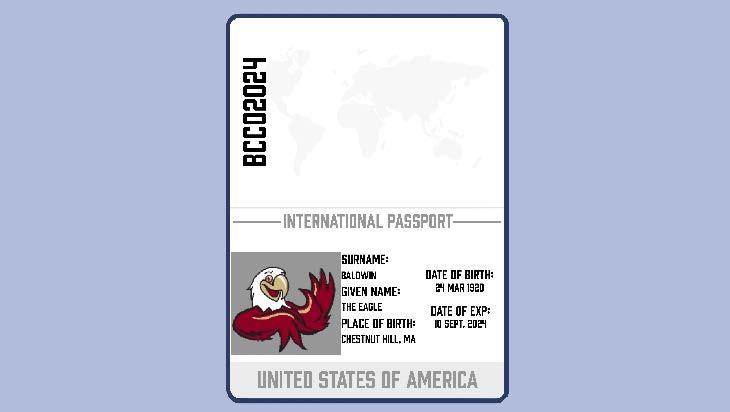
chines that could freeze a quart and a half over 45 minutes, and if you break it down on a per-ounce basis, you would think you’d be able to freeze six ounces in a minute.”
Skulte explained how Fonte’s fierce desire to see his ideas through and determine what is truly possible is what makes him such a successful entrepreneur.
By calculating the power in an average kitchen wall outlet and the freezing point of the dairy in six ounces of ice cream, they determined it was possible to freeze six ounces of ice cream in just a minute.

France, Ireland, and Australia.
While studying abroad, you will most likely have some once-in-a-lifetime experiences that you will want to remember, so I recommend that you find a way to chronicle your semester. If you enjoy writing, buy a journal where you can write about your favorite places, trips, meals, and restaurants.
If you’re into photography, you can take pictures and create a scrapbook. Recently, many exchange students have been creating social media pages dedicated to posts only about their time abroad.
You can make a new Instagram account, create a fun name, and post your favorite pictures from your travels for your friends and family to follow along. Documenting the semester will also help you remember all of the amazing experiences so you can look back on these journal entries or photos years later.
Beginning to prepare to go abroad now will help you be less stressed in the long run.
Studying abroad can be fun, but it can be challenging. So, getting a headstart on preparation will hopefully make the transition all the more smooth, meaning you can savor your time abroad as much as possible. n
Students looking for a laugh in the middle of midterm season packed into Gasson 305, and the comedy club My Mother’s Fleabag delivered.
The group held its first show of the school year on Thursday night, and it was stuffed with staple improv games that kept the crowd involved. Fleabag has been performing at Boston College for the past 40 years and is “the nation’s oldest collegiate improv troupe,” ac-
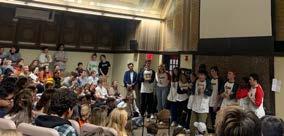
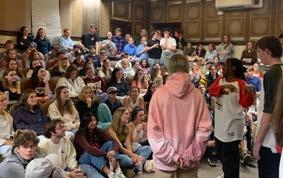
cording to its Facebook and Instagram pages. The comedic chops of its members were on display once again at the fall cafe.
The group consists of 11 members, including three freshmen. Because the group’s performances are entirely improv, each skit takes on a life of its own.
The show was filled with improv games, many of which depended on audience participation. One performer at a time took the stage and directed an improv game. For many of the games, the director asked an audience member
a question to determine the trajectory of the skit, which kept the crowd engaged and excited about the show.
One of the early games was called “Movers and Shakers,” in which Fleabaggers, as they call themselves, could not move their limbs themselves. Instead, an audience member was called up to position them, and the performers had to come up with a scene to match their pose. In one improvised bit, a pair of comedians discussed their passionate romance as they danced together.
Another game was entirely focused around the word “crumb.” Fleabaggers got into a circle, and the two in the front had to perform a scene based on the word. Once the director of the scene decided it had gone on long enough, she told the members to rotate, and a new story based around the word “crumb” would begin.
The scenes were irresistibly funny since the game brought the comedians back to scenes they had already started, and the Fleabaggers had to pick up where they left off.
The audience participation element
was as inventive as the chaotic and humorous scenes that ensued.
The director asked the audience “Who are you here with tonight?”
When an audience member replied “roommates,” the letter “R” became the basis of the game called “A to Z,” in which two performers had to create a scene where each sentence began with the next letter in the alphabet.
The final skit was based around the joke, “[Blank] walks into a bar…” For Fleabag, the blank was filled with “185 car brands” walking into a bar, and the punchline was always a specific car brand. At one point, a Fleabagger threw out “Toy Yoda,” demonstrating the kind of clever humor that the group used throughout the performance with an air of ease.
 By Lauren evans For The Heights
By Lauren evans For The Heights
the paranormal, and the Gothic, all set against the backdrop of Jack the Ripper’s killing spree in Victorian England.
Dreadful engulfs its audience with repeated scenes of horror—slashed throats, women screaming, necks breaking. Prepare to encounter the occult,
Luke Jorgensen, the chair of the BC theatre department, wrote and directed the new play Dreadful, running from Oct. 20 to 23 in Robsham Theater. In this one-act play, Jorgensen experiments with world-blending, bringing together well-known characters from beloved Gothic novels.
“I had an idea for this [play] last year,” Jorgensen said. “I wanted to do something a bit different—a suspense play.”
Gathering inspiration from classic novels like Frankenstein and Dracula, Jorgensen created a world in which these characters can interact with one another, yet the characters still get their own story lines and time on stage.
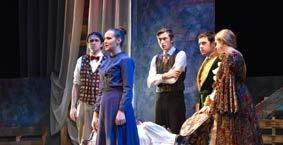
When the lights go down, the audience encounters this new, blended world. The horrifying elements pulled from different novels combine in the play, creating a heightened terrifying energy. Each well-known character’s frightening features multiply upon one another, intensifying the audience’s fear.
An unsettling melody fills the theater as the actors file onto the stage. Their footsteps echo as they take their places, creating a suspenseful atmosphere.
The striking set pieces include Brutalist-style buildings that fill the stage. Candles are scattered across the stage floor, adding to the eerie atmosphere. From the lighting booth, projections stream down onto the set, making the
London street appear foggy. Red streaks of paint track down the buildings, reminiscent of blood—preparing the viewers for the gruesome show ahead.
The play opens with Dracula’s character Doctor Seward (Tyler Dean, MCAS ’25) discussing his scientific studies. In the background, Igor (Benjamin Burke, MCAS ’25) and a woman (Margaret Rankin, MCAS ’25) lie motionless on the stage, like dead bodies. They gradually become more animated before the woman is murdered and Doctor Seward yells, “Hell is upon us.”
In each scene, the suspense builds until, finally, there is a moment of catharsis from a jump-scare or a blood-curdling scream.
In one scene, a fortune teller named Madame Saskia (Megan Malcolm, MCAS ’24) performs a seance. The theater is filled with a warping sound that intensifies as Madame Saskia becomes possessed by one of the spirits.
She spins around to Lord Van Helsing (Ryan Kitz, MCAS ’23) and launches into a Scottish accent, scaring the wits
out of Lord Van Helsing. Before the spirit is exorcized from her body, she lets out a deafening scream and dramatically falls to the ground.
At one point, Jonathan Harker (Daniel Strickland, MCAS ’25) alludes to the play’s historical setting. After hearing news of another murder, he ponders whether the recent disappearances are connected to Jack, referring to Jack the
By Mary Kozeny For The HeightsOcean Vuong compared the publishing of his work to sending a raft down a river: He has to be willing to let go and accept unknown results.
“If you’re on the raft, you can’t make anything,” he said. “You can’t live a life without destroying the raft. In
other words, if you stay on the raft of your work, it traps you.
The Lowell Humanities Series at Boston College welcomed Vuong, a recipient of a multitude of writing awards and a tenured professor at New York University, to speak about his latest book and poetry collection, Time is a Mother, on Wednesday night.
Vuong has received both a MacArthur “Genius Grant” and the prestigious T.S. Eliot Prize for his collection Night Sky With Exit Wounds. His 2019 book, On Earth We’re Briefly Gorgeous, was longlisted for a National Book Award.
Vuong began his series with a poetry reading. His soft voice transformed into a strong melodic tone, highlighting the meter and rhythm of his work as it washed over the packed audience in Gasson Hall.
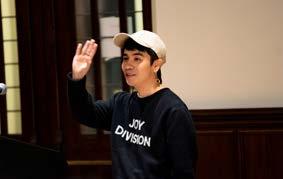
He read poems from his latest work, including “American Legend,” “Beautiful Short Loser,” and “Reasons for Staying.”
Vuong said his latest book of poetry demonstrates his goals to achieve humor, embrace New York, and be more open with language in his work.
Vuong described the way in which he was able to achieve this level of writing and the influence of his childhood and home environment.
“I just didn’t have enough confidence in myself,” Vuong said. “It was difficult to build those registers and also to use humor. Growing up
with the traumatized women who raised me, the joy was very natural–they laughed very easily. I think they knew what was on the other side of trauma and loss and pain. It formed their lives.”
The author’s work frequently explores his identity as a Vietnamese American and his relationship with his mother and grandmother, who immigrated from Vietnam when Vuong was 2 years old.
Vuong described that a turning point in his work was when he decided to stop writing every day. He said it was important for him to redefine what work means, rather than conforming to capitalist demands of daily production.
Kelly Mach, LSEHD ’25, said she knew she had to come to the event tonight as a daughter of Vietnamese immigrants. She said her sister admires his work. Mach had no previous interaction with Vuong’s work, and she was struck by his language and the impact it had on the audience.
“The entire time, I just thought he spoke very beautifully,” Mach said.
“Every word has meaning to it, it has purpose to it.”
Vuong’s use of language is what drew Christy Pottroff, an assistant professor in the English department, to the event. Pottroff said she came because she began to read Vuong’s work during the pandemic, and it touched her.
“He writes really beautifully about grief and loss in ways that I found just especially helpful during the last three years that have been kind of so full of grief and isolation. So I think in reading his books I kind of found like I felt less isolated,” Pottrof said.
Vuong told his audience that he uses literature to explore himself and the world, but most importantly, the dream realm of the imagination. Literature allows endless exploration, he said.
“I could read a poem from sixth century Japan and feel absolute kinship–the loneliness, isolation with joy, within that, as I do now, in my contemporary life,” Vuong said. “To me, that’s real. It's more real to me than often what the news does.”
Charlie Puth’s namesake album CHARLIE is as personal as its name suggests.
It’s his first album since 2018, and it showcases his talent and impressive vocal range. CHARLIE , which came out on Oct. 7, speaks to the feelings and emotions of someone going through a breakup or someone involved in a sort-of relationship.
“That’s Hilarious” is a perfect opener for the album. It immediately demonstrates Puth’s impressive range, and the lyrics and musical structure make it feel like a conversation. The notes come in quick succession, giving the impression that Puth is pouring his heart out to the person who broke his heart.
“Tryna make me feel guilty for ev -
Puth
and emotions from various angles across the albums as he draws out life lessons for his listener. He appears to be trying to make sense of what has happened and framing it as a lesson.
“Light Switch” and “There’s A First Time For Everything” are both fun songs. Although they discuss serious relationship dynamics, the synthesizer and the dance beats give them an ’80s vibe.
One of Puth’s greatest strengths is his perfect pitch. His talent enables him to create backing vocals that complement his main vocals seamlessly. All of the vocals on the album are just Puth harmonizing with himself, which is an impressive musical feat.
 By Kieran Wilson Heights Staff
By Kieran Wilson Heights Staff
There is something profoundly melancholic yet beautiful about Noah Kahan’s songwriting.
On his new album, Stick Season, the Vermont-based musician wrestles with life in small-town New England. He grapples with the people, places, and feelings that he finds himself in and is, perhaps, still searching for.
Known for upbeat pop hits like “False Confidence” and “Hurt Somebody,” Kahan breaks new ground with Stick Season, which came out on Oct. 14, by returning to his folk music roots. He gives extra attention to the personal meaning behind every line of his songs, delivering his best album in an already impressive discography.
The single “Stick Season” came out in July, although the content of the song is more applicable these days as winter creeps closer. The “season of the sticks” that Kahan sings about refers to the time of year in Vermont after all of the leaves have fallen but before the snow has begun to fall. With the landscape barren, Kahan reflects on the end of a
relationship and tries to cope with the tire tracks and single pair of shoes that he is left with.
On the song “New Perspective,” Kahan strikes a fine balance between relaying his personal experiences growing up in a small town in Vermont and exploring the more universal themes of feeling passed by and left behind.
“Oh this town’s for the record now / The intersection got a Target / And they’re calling it downtown / You and all of your new perspective now / Wish I could shut it in a closet / And drag you back down,”
Kahan sings, backed by an acoustic guitar, a mandolin riff, and airy harmonies.
Throughout Kahan’s musical career, he has never been one to shy away from speaking about his mental health struggles, and he deals with the topic again on Stick Season, including on “Growing Sideways.”
Accompanied by a simple acoustic guitar and backing vocals, Kahan reflects on his experiences with therapy and feeling stuck in life.
“’Cause everyone’s growing / And everyone’s healthy / I’m terrified that I might never have met me / Oh, if my engine works perfect on empty / I guess I’ll drive,” he sings.
One of the remarkable things about this record is that for all of its personal reflections on family, home, therapy, and mental health—all of which can be incredibly heavy topics—the tracks still have an air of hopefulness about them.
Even as Kahan sings about lost relationships or the death of his dog, he also sings about the feelings he has for someone
By isaBella DoDaK For The HeightsThe arrival of warm pumpkin spice lattes, sweater weather, and eerie spider webs decorating doors indicate that Halloween is in the air. In order to get into the spirit for this long-anticipated holiday, here is the list of my favorite Halloween-themed books, movies, and songs.

If you are in the mood to be spooked, wrap yourself in blankets with a bowl overflowing with your favorite Halloween treats and watch one of these classic movies:
The Shining (1980)
The Shining is arguably one of the best Halloween films of all time. It’s an ’80s horror classic about author Jack Torrance, who tries to overcome his writer’s block at a haunted mountain lodge. But no work gets done as he disturbingly spirals into an inescapable labyrinth of insanity. As the famous line goes, “all work and no play makes Jack a dull boy.”
The Shining is an incredibly eerie film adaptation of Stephen King’s 1977 novel by the same name. The movie pulls elements from the novel in which ghostly twins plague minds with murderous phantasms and supernatural forces direct malicious acts of evil in the isolated Overlook Hotel.

A Quiet Place is a brilliant fusion of the post-apocalyptic dystopia and horror genres. The plot centers around a family struggling to survive in silence among the ruins of a city plagued with monsters. Although blind, these mon-
strous creatures have an acute sense of hearing that forces the Abbott family to communicate with each other solely through sign language.
With an action-packed plot reminiscent of The Maze Runner and Stranger Things, the film encapsulates the intense thriller mood through the horrifying, Demogorgon-like creatures that lurk within the woodlands.
Nosferatu (1922)
Way before Edward Cullen pioneered the glamorized vampire trope, Nosferatu became the first vampire, as well as one of the first horror films in history. Nosferatu is a German Expressionist adaptation of Bram Stoker’s 1897 novel, Dracula
Although it is a silent film, the devious crescendos of suspenseful background music conjure an utterly sinister mood throughout the story. Nosferatu transports you into the realm of early supernatural cinema.
Psycho (1960)
Alfred Hitchcock, the master of suspense, invites his audience to step into the enthralling narrative of the earliest slasher film in history with his movie Psycho
Along with Vertigo and The Birds Psycho embodies the critical essence of the horror genre as it gradually paints the terrifying events that take place at the Bates Motel. Hidden behind the initial impression of a creepy murder mystery, Hitchcock’s Psycho ascends beyond horror in exploring the
Nostalgia is the currency of popular television these days. From Mad Men to The Wonder Years, TV shows playing with themes of the past have been staples of the small screen. Now that decades like the ’90s are considered “vintage,” it only makes sense that they are memorialized in the form of the sitcom.
Derry Girls takes up this mantle.
The show gets the ending it deserves with season three. It’s funny, sweet, and aware of its meaning—a quality that a lot of sitcoms lack as of late. The nostalgia coursing through the veins of the show is heart-warming and, at times, tear-jerking, much like the experience of being a teenager in itself.
The latest season of Derry Girls, set in 1996 Londonderry, Northern Ire -
land, came to Netflix on Oct. 7 with the same beloved cast from the first season. Erin (Saoirse-Monica Jackson), Orla (Louisa Harland), Michelle (Jamie-Lee O’Donnell), Clare (Nicola Coughlan), and the lone Brit, cousin James (Dylan Llewellyn) are back for the third and final time.
Unsurprisingly, they are up to the usual tricks of past seasons.
Methodically in every episode, the gang falls into mishap after misadventure, peppered by the show’s trademark laugh-out-loud humor and wry observations about the Northern Ireland conflict, known colloquially as the Troubles.
Much like the previous two seasons of Derry Girls, this season combines the brevity of its episodes with the gravity of life as a Catholic teenager living in Northern Ireland. The show achieves this balance in a tasteful and scrappy
way. The show’s production is on par with previous seasons, but there’s just nothing particularly revolutionary about Derry Girls’ third season.
The formulaic nature of the sitcom is both comforting and a bit exhausting—there can never be any rest in dialogue or action. As soon as they solve one problem, the girls get themselves right into the next one, then the next and so forth. The repeated action may deter audiences from bingeing the show.
In the second episode—rather plainly titled “The Affair”—a standard miscommunication about the whereabouts of Erin’s mother, Mary (Tara Lynne O’Neill), propels the entire narrative forward, a plot convention that the creators already used in previous seasons.
What sets Derry Girls apart from its peers, however, is the sheer wit of the

writing, particularly with the character of Sister George Michael (Siobhán McSweeney).
Sister Michael is easily the funniest character on Derry Girls . Her
distaste for her students and clerical counterparts alone elicits laughter in every scene. McSweeney returns to this series with full force, going back to her character’s dry roots.
erything you’ve done / You’re another lesson / You’re just another lesson I learned / Don’t give your heart to a girl who’s still got a broken one,” Puth sings.
examines his experiences

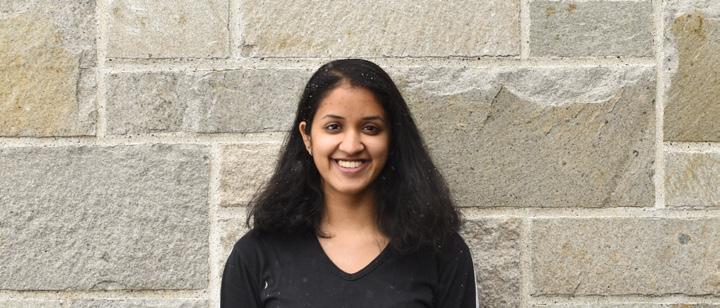
club meeting to attend, or an assignment to do. So in an effort to prepare for the future and promote personal growth this semester, I’ve been doing my best to work on being alone.
For my entire life, I’ve been known as “the loud kid.” Definitely not the one to be quiet and always the one looking to chat. As annoying as my elementary school teachers found my trademark personality trait, I feel as though it has served me well. Thanks to my loose lips, I’ve made more connections, asked more questions, and learned more than if I had chosen a less outgoing path. My propensity for conversation, however, has led to one small issue: I can’t handle being alone.


Seriously, I cannot take it. Whenever I have a moment alone, I immediately begin my search for conversation or companionship. For example, whenever I walk from my off-campus house to campus, I must (must) either walk with a friend or make a phone call during the commute. I won’t go places by myself, I hate empty spaces, and I most definitely can’t stand silence. Recently, I realized this behavior is a symptom of a larger problem: I simply refuse to be alone with my own thoughts. This is not sustainable.
This revelation did, in fact, force me into a minor spiral. It was characterized by the fact that I’m entering adulthood, and adults don’t always have 11 roommates to talk to, a
To all my fellow extroverts out there, be warned. This alone time thing is not for the faint of heart. It takes a considerable amount of effort to get comfortable with being alone, and even more effort to stick with it. Using my newly sought-after alone time, I have reflected on why I hate being alone, and I can explain what I’ve learned from this personal social experiment.

My first revelation in my attempt to get more comfortable with being alone surrounds why I hate being alone, and why it feels especially unnatural while at college— college promotes togetherness. From groupstyle living culture—doubles, eight-mans, off-campus housing, and six-mans dominate the vocabulary of BC students—to the communal nature of almost every college activity, you can go days without having to do a single thing by yourself. For this reason, since coming to college, I believe my discomfort with alone time has matured into a borderline fear. It’s hard to feel good, or even comfortable, about being alone when everything surrounding you promotes togetherness.
But, this fact doesn’t discount the importance of time away from the crowds. Since I started actively practicing spending time alone, I’ve begun to appreciate the importance of checking in with my own thoughts. Like I said earlier, the togetherness of
college can be all-consuming, making it challenging to truly evaluate how you, as an individual, are doing. By actively spending time alone, I’ve created a space to think about my week, my goals for the semester, or anything else on my mind. While I used to hate this self-inquisitive task and viewed it as a green light for internal self-deprecation, I now approach it with an air of kindness. Instead of dwelling on my mistakes, I show myself grace and focus on the things, big and small, that I want to accomplish, instead of the things I’ve failed to do.
I’m sure you’re all wondering what I’ve taken away from my time spent alone. In the interest of honesty, I will admit that I am not yet totally comfortable with being alone, but it no longer scares me. Even if I still prefer joyful company to solemn solitude, I see the personal benefit in checking out of group functions every now and then. Even better, when I think of my life after college, I no longer shudder at the thought of the vast independence and empty time that I will undoubtedly need to adjust to. I’m getting better at doing things without immediately looking for a companion, and I see the benefit of a mental “self check-in.” So if you’re an extrovert—or you were the “loud kid” in elementary school—and you are looking for a challenge, I encourage you to give yourself time alone for a change. You may even be surprised by how much you end up appreciating it.
Typical diagnoses for college students in the fall frequently include colds and allergies, but also include homesickness. Waves of nostalgia draw impacted students into daydreams of the home-grown cafes and landmark street signs that define our hometown lives. Our advice? Remedy the home-shaped hole in your heart by keeping mementos from home nearby. High school sweatshirts, hand-me-down blankets, and lovely stuffed animals are keepsakes of the people and places that shaped us when we miss them most.
It’s well established that Boston College is a school bustling with die-hard Swifties. They make up a huge portion of the student body, but the loyal T-Swizzle bandwagon isn’t unique to BC. Thursday night, the release of Taylor Swifts’ newest album, was a national holiday across the globe. Swifties stayed up waiting for the clock to strike 12, then imagined their wildest dreams in union with Taylor’s relatable tales of heartbreak and self-acceptance. Whether you like it or not, there’s probably many more midnights of dancing and singing your heart out coming your way.
I have a confession to make. There are monsters in my closet.
No, not literal monsters—though that would certainly make for a more interesting story—but the kinds that everyone has. Things like misshapen bags on the floor, heavy jackets slouched onto hangers, and piles of shoes on the ground that, with the lights turned off, look like goblins, ghouls, and gremlins.
Though seemingly innocuous items, these little “monsters” were the epitome of my childhood nightmares. I would lay my head down to sleep and try to make my mind still, only to feel the hair on my neck stand up and feel my eyes crack open once more. In those moments, my well-used personal possessions became creatures of lethal strength, drawing closer and closer every time I risked a peek. As time passed, my aversion to the dark only grew. Every night I was challenged, poked, and prodded in this unending state of discomfort in which I was preyed on by the monsters themselves and their accomplices who hid in the dark.
Suffice it to say, I hardly slept a wink in my early childhood years.
Ultimately, my pride caused me to seek a solution. I came to the conclusion one day


that my fear of the dark was unbecoming of my dignified 8-year-old self. I could not bear the humiliation of admitting that I was scared of my own puffer. It simply wouldn’t do. So I forced myself to sit in my pitch-black room, waiting for the moment where I wouldn’t feel the monsters’ creep. It was a truly uncomfortable experience, yet after several months I began to embrace the darkness as an old friend. I marveled at the way that, given a little time, the monsters could transform into friendly dragons, unicorns, or even imaginary best friends. I started to look forward to going to bed, eager for the moment I could turn the lights off and talk to these creatures about the people and places I saw.
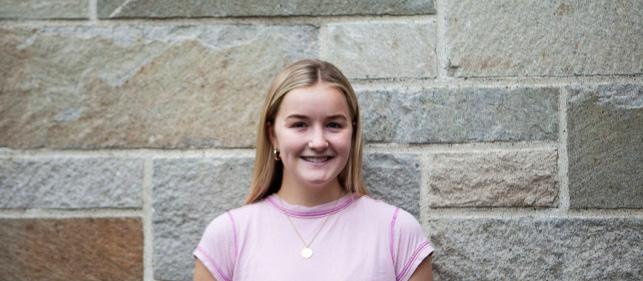
I have thought about this quite a lot recently. Perhaps it’s because spooky season is around the corner (I have seen more plastic Frankenstein heads at CVS than I ever needed), but I’ve recently thought about the monsters that used to scare me and the ones I might have today. My mind is practically the space that my closet used to be—filled with ideas, memories, and monologues, that serve as the visor through which I interact with the world. It is in this mental closet that I perceive others and feel empowered to represent my truest self among them. On some days, however, when I am feeling exhausted or vulnerable, I feel the monsters start to materialize in the crevices of my brain. They whisper falsehoods about my character, abilities, and future prospects as I cower at the center of a room I no longer recognize. When these voices get loud enough, I feel immobilized, unable to lead in the commitments I am involved in, laugh with
my closest friends, or focus in my classes. I feel trapped in my own mind.
I must admit that these monsters are more formidable foes than the ones I grew up with. They try to convince me that I will never become the person that I want to be, never reach the goals I set for myself, or create the life I have dreamed of. They create a false perception of my reality that seems so incredibly believable and yet only exist in the shadows of my brain. But that presence—knowing this perception is only in my head and nowhere else—is actually what makes it comforting.
My child self has taught me how to sit with these monsters and be. Just like holding my breath while underwater, I can sit and wait with the monsters until they transform into shapes I can recognize and befriend. Sure, they may return in forms more grotesque and all-consuming, but they are, at the end of the day, shapes to be molded and remolded until I return back to myself and remember who I am.
In short, I can now say with all due edginess that I have embraced my darkness. As much as I have despised them, I am grateful for what the monsters have taught me about myself. And while they may never completely go away as they did when I was a kid, they have become beings that I work with as I move through life.
So as this spooky season comes to a close, and the plastic little Frankenstein heads disappear from the shelves, I must ask you: What’s in your closet?
A few weeks ago, we gave a shout-out to the reopening of the Eagle’s Nest Deli. Once optimistic for a strong sandwich-filled semester, we now are filled with despair as we address the lack of pressers at this go-to lunch spot. Maybe we’re asking for too much—and maybe having both the deli and pressers is downright greedy— but our longing for chicken parm and meatballs on the second floor McElroy Commons only reflects our love for this student favorite.
It’s October, and that means Boston temperatures will ping-pong from the mid-70s to high-40s in the blink of an eye. These weather changes have led, unfortunately, to sweltering artificial heating in many of our classrooms and residents halls. To us at TUTD, it feels like BC’s entire heating infrastructure is perpetually one to two hours behind the conditions outside, so this heating rarely helps us cope with the ever-so-variable Massachusetts weather. And don’t even think about opening a window to escape it.
Boston College should fulfill its responsib ility to provide a safe living environment for its students by installing emergency blue lights around off-campus housing. Recent reports of attempted break-ins this year and increased reports of rape and stalking in 2021 demonstrate that BC must provide a security system for the hundreds of students that are not guaranteed four years of housing.
In compliance with the Clery Act, BC’s recently released crime statistics show that reports of both rape and stalking increased in 2021. In particular, there were 14 reported cases of stalking in 2021, a 220 percent increase from 2020. This statistic, alongside BC’s consistently high rates of sex offenses compared to peer schools, reveals serious threats to the safety of students.
Only five of the reported 14 stalking cases in 2021, however, occurred at on-campus housing facilities. This means that nine of the 14 stalking cases—well over half—occurred off campus. These statistics do not include attempted break-ins, which have recently gained the attention of BC’s off-campus community. In particular, a masked man has appeared multiple times outside of students’ off-campus houses, seemingly attempting to break in.

Given that studies have shown that sex crimes in colleges and universities are almost always underreported, the true number of stalking cases off campus at BC
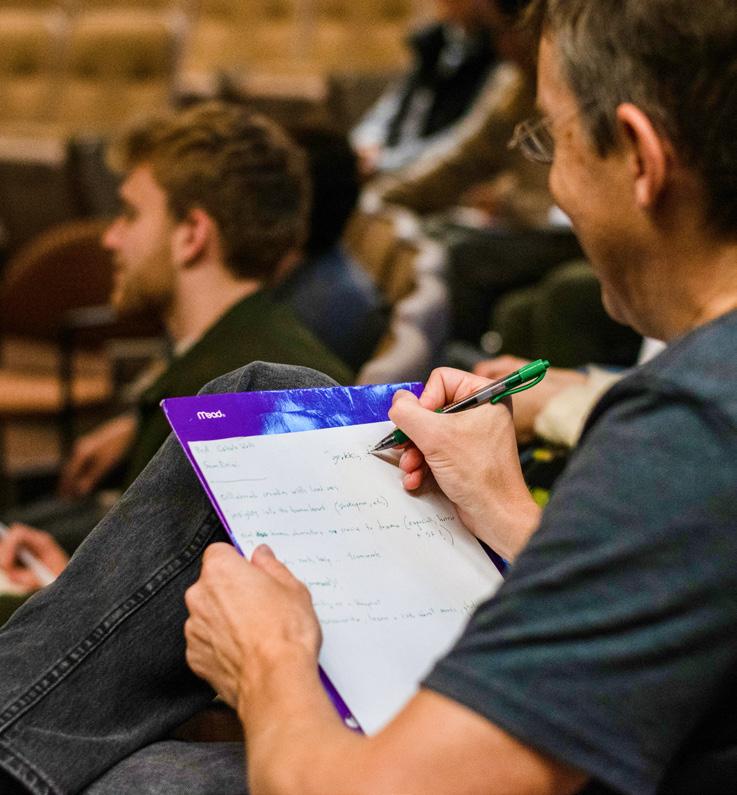
in 2021 could be much higher than 14. To combat off-campus criminal activity, the BC administration should consider installing safety equipment on nearby residential streets to ensure that students feel safe while living in their off-campus neighborhoods.

While BC uses a variety of safety measures on and nearby campus, their most visible is the blue light system—brightly lit boxes that call BCPD to the blue light’s location with the press of a button. Over 100 of these boxes are scattered across BC’s three campuses, with their blue lights visible nearly everywhere on campus, especially at night.
Even though these boxes play a critical role in protecting students from the risk of rape or stalking, there are no such installations in the neighborhoods surrounding BC’s campus.
BC, like many other universities, does not guarantee all undergraduate students four years of housing. Instead, the majority of students receive three years of guaranteed housing, with many students opting to live off campus their junior year. Thus, in any given year, hundreds of BC students live near BC’s campus in the City of Newton and Brighton, a neighborhood of Boston.

Given that BC is in two cities at once, it could make it difficult for the administration to install blue light boxes outside of
its campus. After all, BC has a complicated history of cooperating with Newton.

Yet, universities in similar situations have been able to work with their respective municipalities to install blue light systems around their own off-campus housing. Washington University in St. Louis, Northwestern University, and Ohio State—all of which are also surrounded by dense cities and suburbs—have extensive blue-light systems around their off-campus housing. This demonstrates that working with local governments to install emergency systems is possible.
In the long term, BC has indicated plans to add over 1,600 beds worth of housing to Lower Campus and Brighton Campus, thereby possibly removing the need for off-campus undergraduate housing. These plans, however, are subject to change and would not be completed for many years. Current off-campus undergraduates cannot wait years for BC to create safer housing.
A failure to install off-campus emergency blue lights thus dismisses student safety—which inevitably extends beyond BC’s boundaries—leaving students who live off campus with an unfair lack of support from the University. The administration should work to provide off-campus blue light emergency systems as soon as possible.
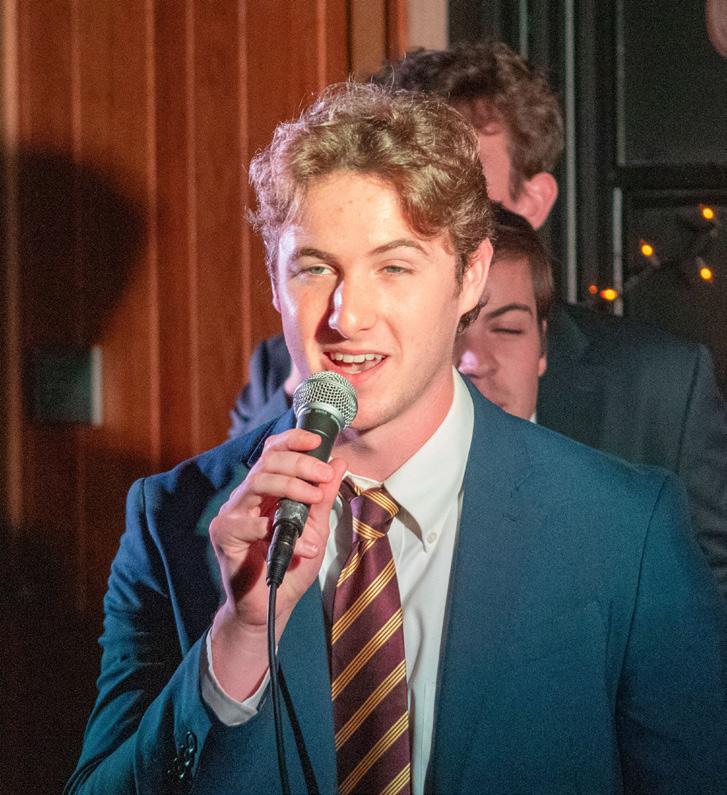
BCPD did not respond to multiple requests for comment.

T op photos, left to right: The Museum of Fine Arts opened its LIFE exhibit this week, showcasing the photography magazine’s impact on the world. Friday, Oct. 21, 2022; As the weather gets colder and the leaves start falling, the people of Newton decorate their town to celebrate the season. Saturday, Oct. 22, 2022; The BC theatre department performed Dreadful, a shocking and suspenseful Halloween-esque play written by BC’s own Luke Jorgensen. Wednesday, Oct. 19, 2022.
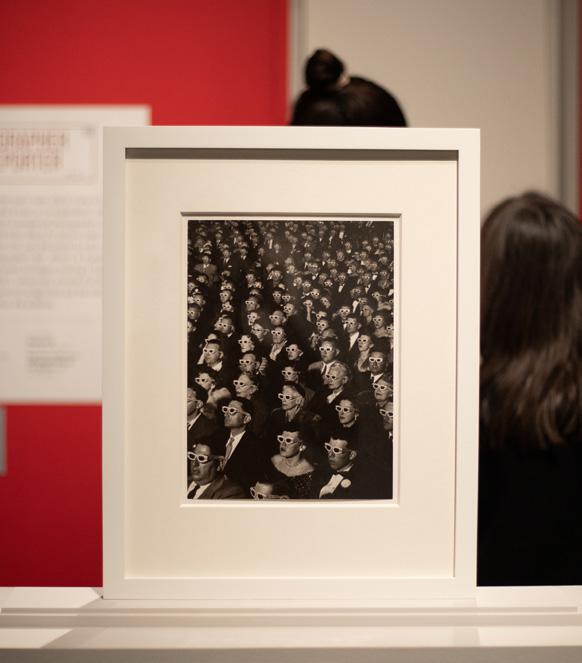
Bottom photos. left to right: Director Sam Raimi spoke to a select group of film students about writing, directing, and how to enter the entertainment industry. Thursday, Oct. 20, 2022; The BC bOp! Jazz Ensemble brought the Vanderslice Hall Cabaret Room to life with its jazz soloists and singers. Friday, Oct. 21, 2022; This weekend, the BC Acoustics hosted their Halloween Invitational with special guests, The Heightsmen. Friday, Oct. 21, 2022; A BC field hockey player defends the ball from the BC goal. Friday, Oct. 21, 2022.
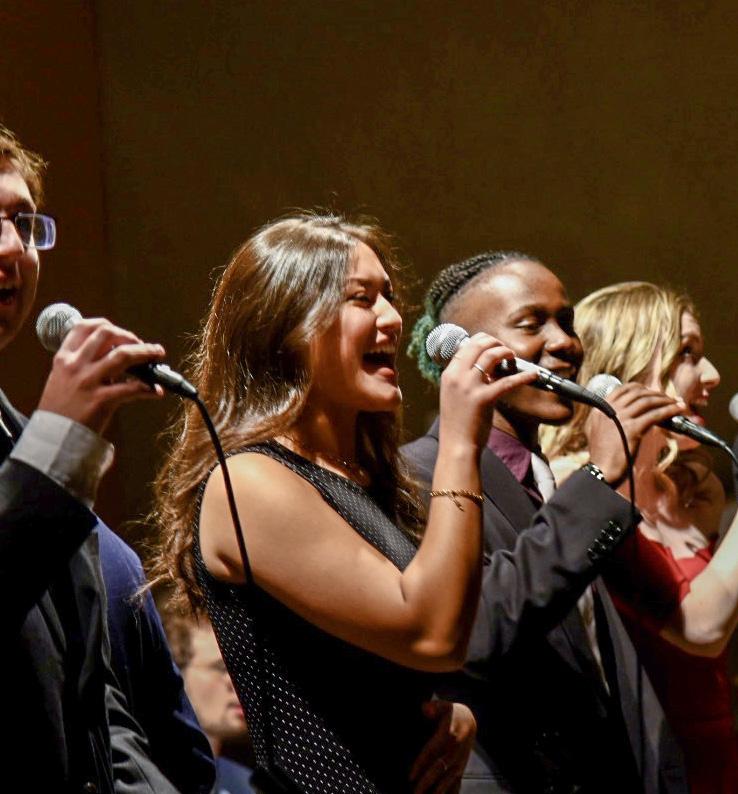
Wake Forest ripped the heart out of Boston College football last year, as Wake dominated BC 41–10 to end the Eagles’ 2021 season.
Coming off a bye week, BC was looking for a much different result against the Demon Deacons (6–1, 2–1 Atlantic Coast) this time around. And while the Eagles (2–5, 1–4) scored five more points Saturday than they did in 2021 and were down just 21–9 at halftime, the result was largely the same in a 43–15 loss for BC.
BC quarterback Phil Jurkovec looked sharp at times, especially when utilizing his legs, but he also struggled to hit his receivers in stride. The offensive line fared no worse than it has this season—even with Jackson Ness making his first career start at center as Drew Kendall was out with a broken wrist—and allowed two sacks.
Wide receiver Zay Flowers—who leads the ACC in reception yards— shined, tallying 135 yards on 10 receptions and carrying the Eagles for as long as he possibly could.
“It’s always difficult,” Flowers said of remaining optimistic amid a losing season. “But I just try to stay positive and just try to keep the energy and locker room positive so we can always go out the next day and play hard and work hard and just do the best we can every game.”
BC implemented designed runs for Jurkovec—something the Eagles haven’t done much of this season. In BC’s second drive of the game, Jurkovec’s gains for 12, nine, and three yards on the ground helped the Eagles get within five yards of Wake’s endzone. But a false start on offensive lineman Jack Conley sent BC back, forcing it to kick a 29-yard field goal on a missed opportunity.
“That’s something we looked at [this week] and we need to have more success
with, and I think that we did,” BC coach Jeff Hafley said of Jurkovec’s increased rushing plays. “Some of them were scrambles, but there were a handful of designed runs. … It’s something I think we need to continue to build off of because we had success doing it.”
Wake’s high-powered offense— which had 20 total passing touchdowns on the season heading into Saturday’s game, good for second best in the ACC— kicked into gear near the end of the first quarter. Sam Hartman found Jahmal Banks on a back shoulder throw for the score over BC’s Elijah Jones.
BC’s defensive line struggled to put any pressure on Hartman or running back Justice Ellison. Ellison and Christian Turner’s patient approaches with the football—reminiscent of Le’Veon Bell’s glory days in Pittsburgh—carried Wake. The Demon Deacons ran for 115 yards, helping Wake tally 29 first downs all game to BC’s 15.
“It’s tough to defend,” BC defensive end Marcus Valdez said. “Everyone has to try to attack it different. But at the end of the day, it’s tough, and you gotta tough it out and try to force [Wake] to, you know, either throw it or pass it and try to speed it up.”
An off-script fake punt on fourthand-8 by Danny Longman for 24 yards kept the Eagles’ drive alive. It was the longest run of the game for BC.
A wild play from both sides—a fumble from Jurkovec on a fourthand-11 pass attempt that was recovered by Wake’s Jasheen Davis, who subsequently fumbled once again after Conley got his hands on the ball—ensued. BC recovered, got a new set of downs, and Jurkovec found a wide open Flowers on a 61yard touchdown to cut Wake’s lead to 14–9.
By graham Dietz Assoc. Sports EditorAfter jumping out to a 4–0 start in the 2021 season, Boston College football looked impossible to beat. And then October hit.
Four consecutive losses—first to ranked opponents Clemson and NC State and then to unranked opponents Louisville and Syracuse—prompted head coach Jeff Hafley to take a reality check.
It wasn’t until Week 10—when Hafley got his starting quarterback back from injury—that BC surpassed 14 points in a game since it defeated Missouri 41–34 in overtime. Despite its miserable October campaign and going 1–2 in its final three games, BC was still bowl eligible.
This October hit even harder.
On Oct. 1, BC defeated Louisville 34–33. Since that victory, BC’s opponents have outscored the Eagles 74–18.
At this point last year, the Eagles were 4–3. They’re 2–5 now. If Hafley doesn’t flip the switch, bowl eligibility is surely out of the question in 2022. BC’s 43–15 loss at Wake Forest on Friday was just the icing on the cake.
Here are three observations from the loss.
Too Much Hartman to Handle
In a conference that’s stacked with potential NFL quarterbacks, Wake Forest QB Sam Hartman is one of the best. Hartman’s QBR of 78.4 is good for 17th in the nation. He’s ranked fifth in passing touchdowns with 21. Hartman has nearly eclipsed 2,000 passing yards this season and has registered 71 rushing yards and a rushing touchdown. He’s got the seventh best passing efficiency in all of the FBS—for every seven touchdowns Hartman throws, he’s thrown just one interception.
Hafley’s coaching resume has primarily been in coaching defensive backs. Now, as a head coach, Hafley’s BC teams have been elite against defending the pass since his arrival on the Heights. But in BC’s loss to Wake, Hartman outmaneuvered Hafley’s defense.
Hartman finished with 313 passing yards on 25 completions while throwing five touchdowns to three different receivers. He was responsible for a sixth score on a 2-yard touchdown trot with less than a minute left in the third quarter.
Hartman was especially stellar in the red zone, where he made well-timed throws on quick decisions into the end zone. All five of his touchdown passes came on throws of less than 17 yards.
It started with a back-shoulder throw to Jahmal Banks with 1:30 remaining in the first quarter. Hartman dropped
back, stuck out his hips to the left side of the field to stray away BC’s safety Jason Maitre from his primary read, and tossed a confident ball to the pylon. Banks made the play with BC’s Elijah Jones in coverage. From there on out, Hartman made BC’s defensive backs look flat-out hapless.
Hartman showed a poise on his progressions that is a rare trait for college quarterbacks, due in large part to Wake’s pro-style offense. Hartman once again showed why he can outplay any quarterback in the FBS. He’s not just one of the ACC’s best—he’s one of the nation’s most fine-tuned signal callers.
Lack of Discipline and Pressure on the Quarterback
In its last two matchups, BC’s defense has shown abysmal play in the trenches. The interior defense has a combined nine tackles for loss and four sacks in two games, well below its marks in the Eagles’ first five games. The lack of pressure on opponent quarterbacks is catching up to BC’s play in the secondary.
Total tackles have decreased for the Eagles’ defense in recent games, and it’s due to a lack of pursuit in the field. Linebacker Kam Arnold made a career-high 12 tackles at Virginia Tech on Oct. 22, but in BC’s last two games, the Eagles’ leading tackler combined for just 13 total tackles. Linebacker Vinny DePalma has been limited, too, recording just seven solo tackles in two games. Against ACC opponents, BC is facing tougher and more durable offensive linemen, many of whom are NFL-scouted players.


The penalties added up for BC in its loss to the Demon Deacons, and it’s not just a matter of the defense. Early jumps on the offensive line have been a consistent problem for the coming-and-going, injury-prone group that has to protect quarterback Phil Jurkovec. The Eagles recorded 11 penalties for 104 yards. Pursuit and penalties will need to improve in the coming weeks for both BC on both sides of the ball.
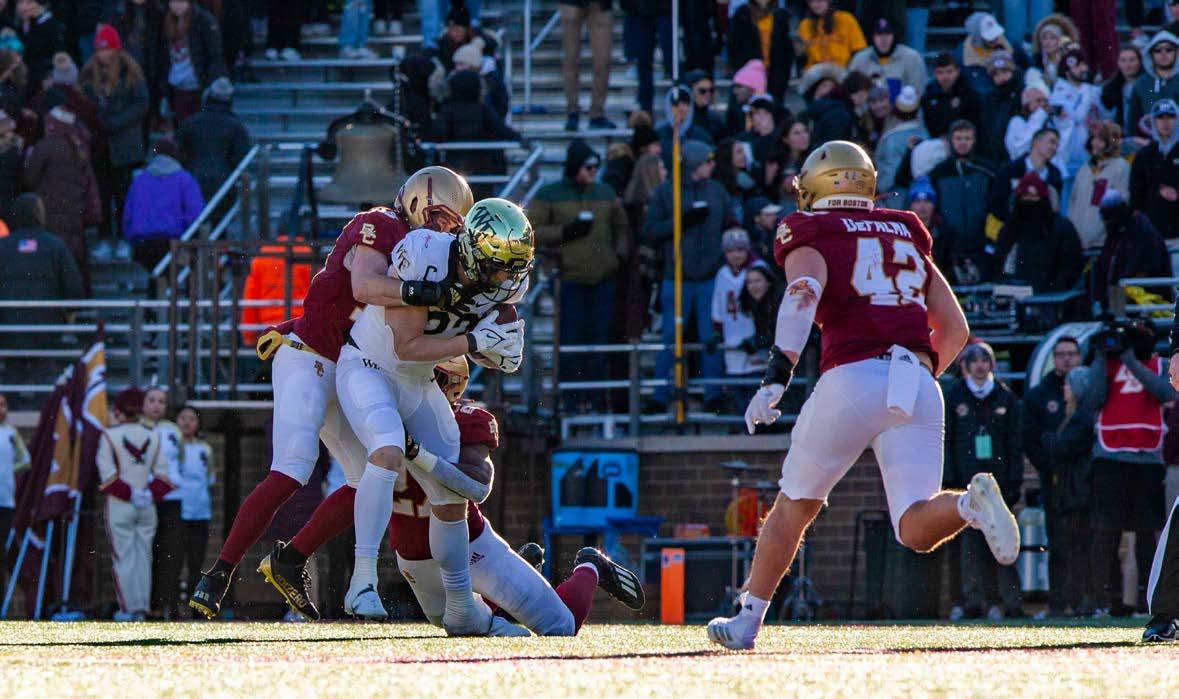
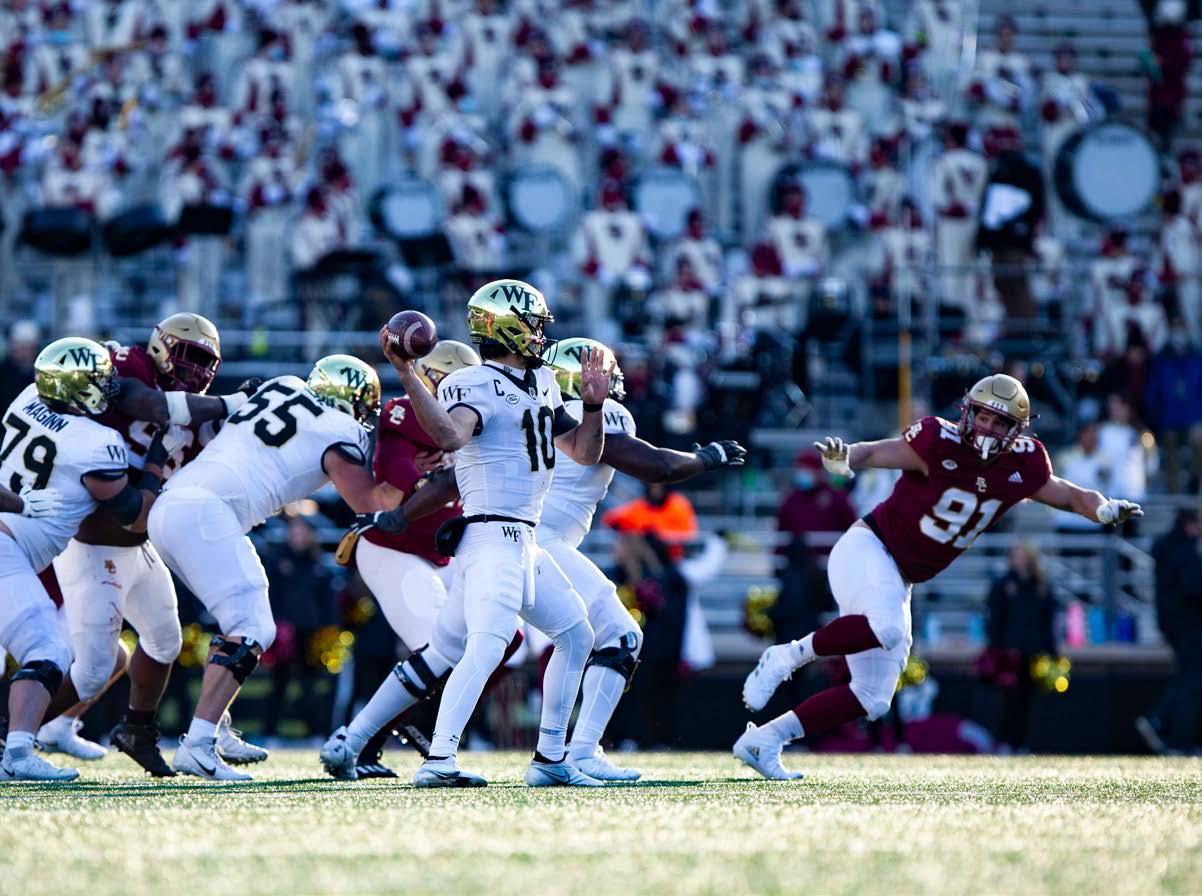
Throw to Zay and Pray Saturday wasn’t the first time wide receiver Zay Flowers didn’t look thrilled to be on BC’s sideline. After reports came out that Flowers turned down a six-figure NIL offer to transfer, BC fans have been pressing their fists to their foreheads in pure sympathetic agony for who some say is college football’s most dominant deep threat.
Just past the six-minute mark of the second quarter, Flowers made one of the
Missed opportunities on offense hurt the Eagles, who were creating chances but couldn’t find the net. On a breakaway play, Mia Garber swerved around BU goalkeeper Caroline Kelly, sending her to the ground, but she missed a wide-open net mere inches to the right of the goalpost.
“I think we had all the opportunities,” Doton said. “I think the scoreboard says 16 shots [on goal] so we definitely had the opportunities. They just weren’t falling, but they persisted with it and kept going.”
Milagros Arteta and Sarah Johnson also had chances late in the second quarter, both firing darts toward the goal, but Kelly got in front of both—a common theme for the Eagles, who tallied 11 shots but only one goal in the first half.
BC’s nine total penalty corners surpassed its season average of just under six per game, but the Eagles only converted on one of them Sunday. BU, meanwhile, recorded three penalty corners and scored its only goal off its


first one, which came with less than two minutes in the second quarter. Payton Anderson’s shot that went right under Gillespie’s kick-block attempt, tying the game.
“I just think our energy is down a little bit,” Doton said at halftime. “We let them back in the game with the corner. … We just need to get our energy going [in the second half].”
The Eagles’ energy was noticeably higher to start the third quarter. BC put pressure on the Terriers’ defense, as Martina Giacchino found a gap, but her shot hit the post. Giacchino’s shot came
amid nine consecutive shots in a span of 10 minutes for the Eagles.
“They just looked lethargic,” Doton said about her team in the first half. “So [I] just gave them some tactical points. But the most important thing is their controllables, and that’s their energy, and they brought it in the third quarter, and they got rewarded because of it.”
Heck’s acrobatic goal finally broke the tie. She displayed her excellent hand-eye coordination by flicking the ball above Kelly for the score—her fourth goal this season.
The floodgates opened after Heck’s
goal. Margo Carlin followed up not long after with a goal off her own rebound in the third quarter.
But it was the Eagles’ defense that remained their strong suit for the rest of the game, holding the Terriers to one goal and just two shots in the second half.
“[It’s] really important,” Doton said of BC’s defense. “That was the emphasis going in, that we have to have a fortress in that defensive circle, definitely moving forward if we want to make it to the NCAA tournament. So I was happy for them.” n
Boston College women’s soccer had scored just two goals in its past eight games against ACC opponents entering its road matchup against Clemson on Sunday.
Against the Tigers, BC’s offensive woes continued, as the Eagles (5–8–4, 1–7–1 Atlantic Coast) failed to score and generated few promising chances in a 3–0 loss to Clemson.
Clemson dominated possession in the first half and created a handful of scoring chances in and around the Eagles’ penalty box. Forward Maliah Morris broke the deadlock when she maneuvered behind the Eagles’ back line and snuck a left-footed shot through the legs of BC goalkeeper Wiebke Willebrandt just over 12 minutes into the game.
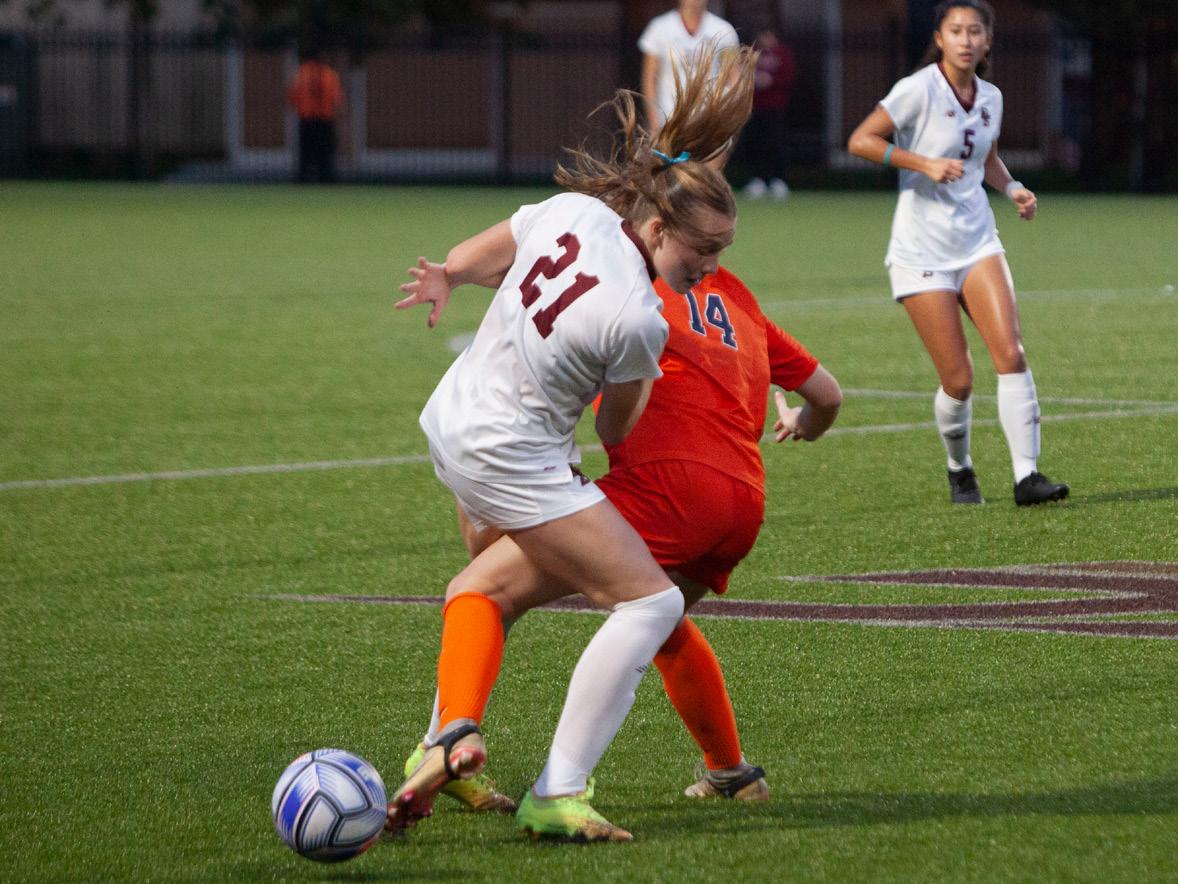
The Tigers continued to control the game and doubled their advantage in the 25th minute when forward Sami Meredith slotted home a rebound from just six yards out after a shot by Renee Lyles hit the crossbar. Lyles and her fellow wingers consistently caused problems for BC’s outside backs throughout the half, as their speed and willingness to make vertical runs in behind the back line led to each of the goals.
BC struggled to build out from the back from the start and had a difficult time connecting passes in the midfield as the first half wore on. Senior forward and leading scorer Sam Smith found limited opportunities up front and spent most of the first 45 minutes of play chasing poor clearances that her teammates made.
The Eagles dodged a bullet late in the first half when referees didn’t call a penalty on a rough play. What
looked like a clear trip in the box was deemed a clean tackle, and the Eagles went into the halftime break down 2–0 without having to defend a penalty.
The Tigers continued their relentless attack at the start of the second half, and Meredith tapped in her second goal of the game early in the half off a cross that deflected off BC defender Michela Agresti.
Clemson continued to pressure the Eagles after they conceded their third goal, but when freshman forward Sydney Segalla came off the bench, the Eagles experienced an offensive spark.
Segalla nearly capitalized on a breakaway midway into the second half, but her right-footed effort slid just outside the left post. She continued to look dangerous after the missed breakaway, and she forced Clemson goalkeeper Halle Mackiewicz to make a tough save just a
couple minutes later.
Despite finding some energy late in the second half, BC’s offensive woes continued to haunt the Eagles in the 3–0 loss. They failed to find
the back of the net for the seventh time in nine ACC contests and head into their final game of the season sitting at the bottom of the conference standings. n
Mitch Benson has had quite a week.
Boston College men’s hockey’s goaltender recorded his first victory in a BC sweater against New Hampshire on Oct. 15 and posted a 32-save effort against Northeastern on Tuesday. On an afternoon when the Eagles failed to convert on a number of early offensive opportunities, they needed Benson to come through for them again.
Benson did just that, stopping 22 shots en route to his first shutout of the year. After erupting for
three goals in the second period, BC (2–1–1, 2–0–0 Hockey East) cruised to a 5–0 victory.
“All year, [Benson’s] been rock solid,” BC head coach Greg Brown said. “It’s great when you have a veteran guy like that. He’s very calm in the net … he just doesn’t get rattled.”
Stifled by a stingy Eagles’ defense, the Wildcats (3–2–0, 0–2–0) only mustered seven shots in the game’s opening 20 minutes—with their first coming over seven minutes into play.
BC, meanwhile, put New Hampshire goaltender David Fessenden to work early, sending 24 shots in his direction. The Eagles’ heavy offensive pressure forced the Wildcats to clear the puck often. Of those
24 shots, however, only 12 were on goal, keeping the game scoreless heading into the second frame.
“We were fortunate—even though we didn’t score—to do a decent job and not get impatient when pucks weren’t going in,” Brown said.
Just minutes into the second period, officials called a slashing penalty on Nikita Nesterenko, handing the Wildcats the game’s first power-play opportunity.
As the power play expired, Nesterenko emerged from the penalty box and streaked toward the net, creating an odd-man rush. Fessenden stopped Nesterenko’s scoring bid, though, with a sprawling pad save.
But the Eagles wouldn’t remain
scoreless for much longer.
New Hampshire was soon called for a slashing penalty of its own, putting BC on the man advantage.
Looking for his first career goal, freshman defenseman Lukas Gustafsson positioned himself right by the face-off circle, waiting for a pass. Oskar Jellvik then rewarded Gustafsson’s patience, sliding him a perfectly placed pass to set up a one-timer goal.
The flood gates then opened up in the period’s final minute.
Nesterenko made up for his missed chance earlier, firing his first goal of the year past Fessenden. Trevor Kuntar followed up 38 seconds later with a score off a rebound, securing a comfortable
3–0 lead for the Eagles.
“It wasn’t until we got those two late goals in the second that we could breathe a little easier,” Brown said.
BC’s offensive explosion continued into the final period.
Halfway through the third period, Cutter Gauthier cleaned up after Cade Alami’s missed shot to put the Eagles ahead by four goals. Mike Posma joined in on the scoring barrage for BC’s fifth goal, capitalizing off of a blocked shot and sealing the Eagles’ shutout.
“I thought we had our most sound game tonight,” Brown said. “I think for 60 minutes, that was the most consistent we’ve been so far.” n